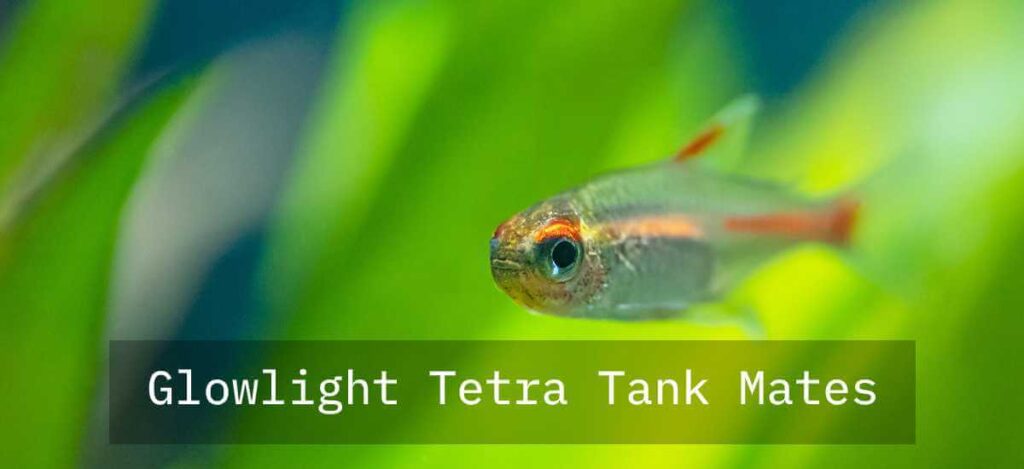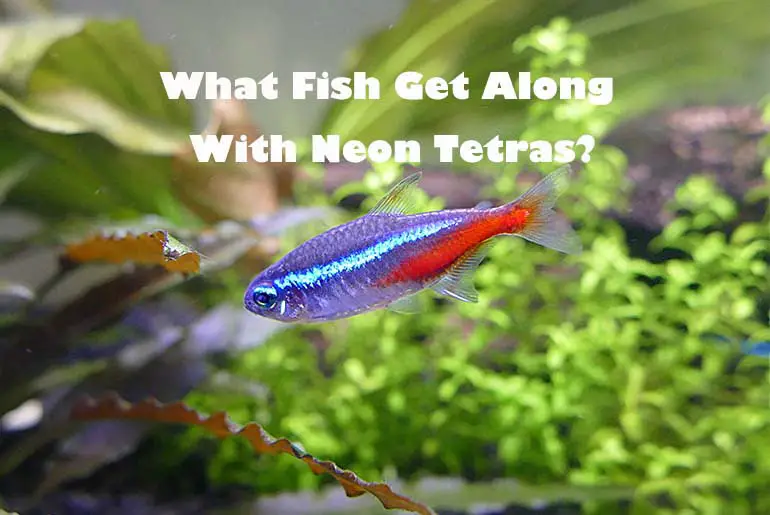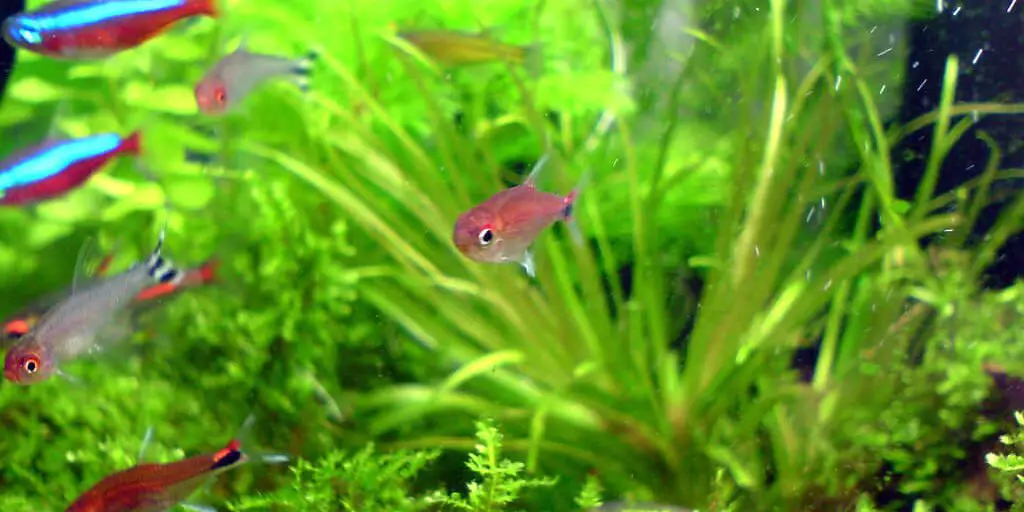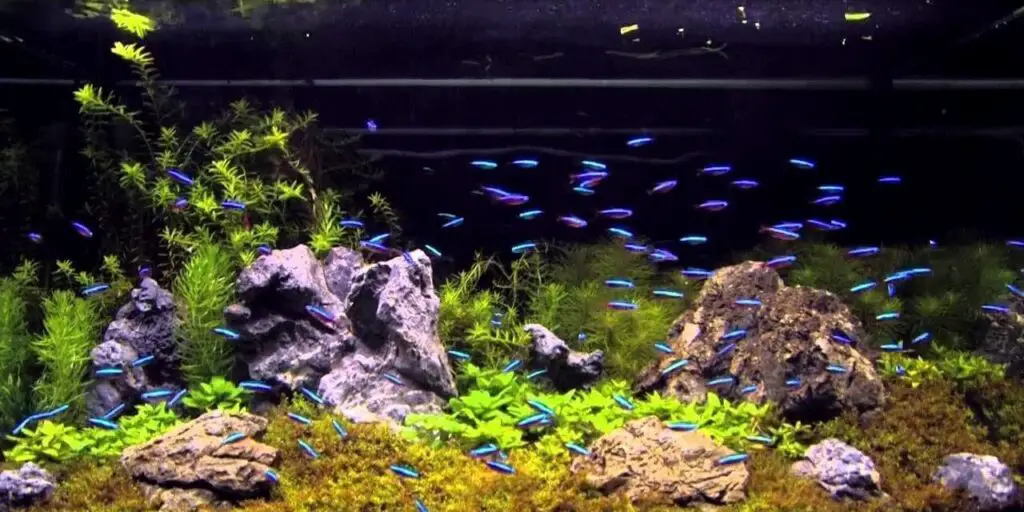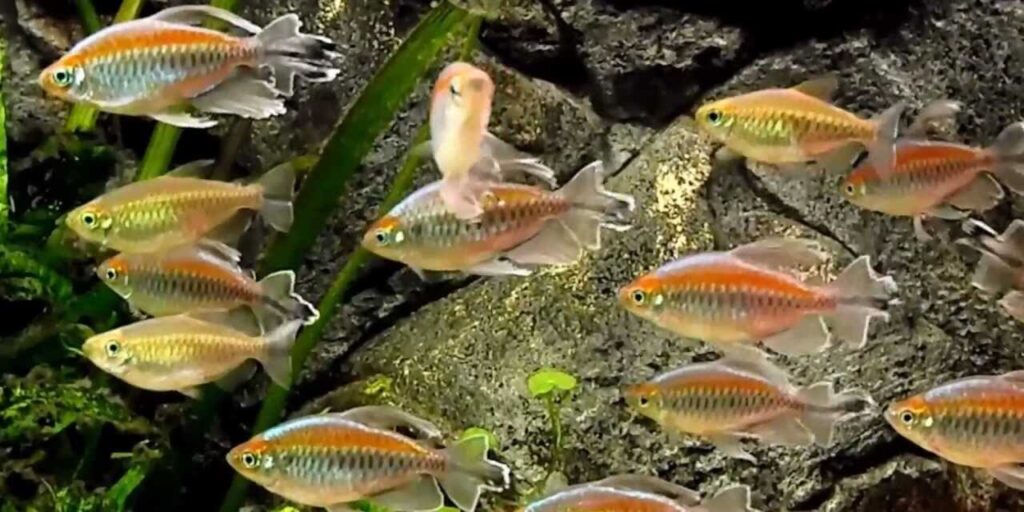Dive into the vibrant world of aquatics with our guide to Glowlight Tetra tank mates. Glowlight Tetras, with their captivating luminescence and peaceful disposition, are a favorite among fish enthusiasts. Yet, creating a balanced and visually stunning aquarium involves curating the perfect community.
Explore a variety of suitable companions for your Glowlight Tetras, including tetras, danios, livebearers, gouramis, loaches, rasboras, and catfish. These fish add color and diverse behaviors to your tank. Let’s delve into the top choices for an enjoyable aquatic community.
Understanding Glowlight Tetras and Their Need for Tank Mates
Glowlight Tetras, scientifically known as Hemigrammus Erythrozonus, are captivating freshwater fish with shimmering silver bodies adorned by an iridescent red stripe. Their peaceful temperament and captivating appearance make them a popular choice among aquarium enthusiasts.
In their natural habitat of slow-moving rivers and forested areas in Guyana, Glowlight Tetras exhibit a tendency to form shoals. This behavior highlights their need for companionship and safety in numbers. When kept with compatible tank mates such as other Tetras, danios, livebearers, gouramis, loaches, rasboras, and catfish, they mirror their natural behavior, promoting social interactions and reducing stress.
If you want to learn more about how many Glowlight Tetra you can add to your tank, reat the article.
Glowlight Tetra Overview Table
| Characteristic | Details |
| Scientific Name | Hemigrammus Erythrozonus |
| Common Names | Glowlights, Glowlight Tetra, Fire Neon Tetra |
| Group | Freshwater |
| Origin | Guyana |
| Adult Size | 1-1.5 inches |
| Lifespan | 4-5 years |
| Minimum Tank Size | At least 15 gallons (long) |
| Diet | Food Flakes, Pellets, Larva, Brine Shrimp |
| Required pH | 6 – 8 |
| Preferred Temperature | 22 – 28 degrees Celsius |
| Temperament | Peaceful |
| Care | Easy |
Factors To Consider When Selecting Glowlight Tetra Tank Mates
As we selected suitable tank mates for your Glowlight Tetras, we took into account important aspects to ensure a peaceful underwater community. These considerations guided us in creating the data table highlighting the best companions for your Glowlight Tetras.
Here is how you can set up fish tank for your Glowlight Tetra
Size Compatibility:
Consider matching the size of potential tank mates with your Glowlight Tetras. It’s essential to choose fish that are similar in size to avoid any potential issues.
Water Parameter Harmony:
Maintaining a stable and suitable environment is key. Select tank mates that share similar water requirements regarding temperature, pH levels, and water hardness to ensure a balanced aquatic ecosystem.
Temperament and Behavior:
Understanding the behavioral traits of both Glowlight Tetras and potential tank mates is crucial. Seek companions with compatible temperaments to prevent conflicts and promote a tranquil tank atmosphere.
Dietary Needs:
Considering the dietary requirements of your potential tank mates is vital. Opt for fish that have comparable food preferences to simplify feeding routines and ensure all inhabitants receive a well-rounded diet. If you want to learn more about the dietary requirement of your Glowlight tetra, check out the article.
Catfish
Catfish are usually too big for glowlight tetra buddies, but don’t worry! I’ve found some awesome small catfish pals like Bronze Corydoras and Panda Corydoras that’ll be great roomies for your glowlight tetra fish.
Bronze Corydoras
Bronze Corydoras (Corydoras aeneus) are a popular choice as tank mates for Glowlight Tetras due to their peaceful nature and compatibility.

| Category | Details |
| Physical Characteristics | These small catfish typically reach a size of around 2.5 inches and display a beautiful bronze or coppery coloration, adding visual appeal to the tank. |
| Behavior and Temperament | Bronze Corydoras are peaceful bottom-dwelling fish, adding activity to the lower levels of the tank. They are social and thrive in groups. |
| Water Parameter Compatibility | They prefer slightly acidic to neutral pH (6.0-7.0) waters and a temperature range of 72-78°F, aligning well with the requirements of Glowlight Tetras. |
| Dietary Needs | Their omnivorous diet includes sinking pellets, flakes, and occasional live or frozen foods, ensuring they won’t compete much with Glowlight Tetras for food. |
| Tank Size and Grouping | A 20-gallon tank or larger is suitable for a group of Bronze Corydoras, allowing a peaceful community with Glowlight Tetras and other compatible fish. |
| Visual Appeal and Community Dynamics | Bronze Corydoras contribute to a lively and visually appealing aquatic community, especially at the bottom levels of the tank. |
| Compatibility Considerations | Their peaceful and social nature makes them excellent companions for Glowlight Tetras, enhancing the overall community dynamics. |
Corydoras Catfish
Corydoras Catfish, scientifically known as Corydoras, are popular tank mates for Glowlight Tetras due to their compatibility and beneficial qualities.
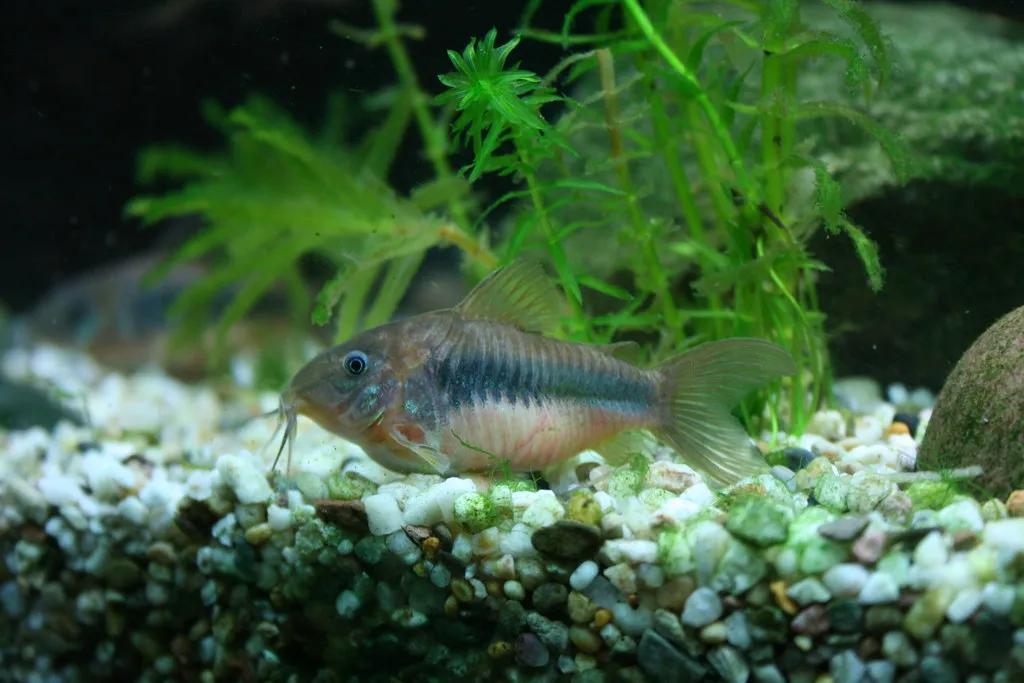
| Category | Details |
| Physical Characteristics | These small catfish display a compact, armored body with various colorations and patterns, making them visually appealing additions to your tank. |
| Behavior and Temperament | Corydoras Catfish are peaceful and social creatures, known for their playful antics and bottom-dwelling behavior. |
| Water Parameter Compatibility | They thrive in a pH range of 6.0 to 7.8 and a temperature between 72-79°F, aligning well with the needs of Glowlight Tetras. |
| Dietary Needs | Corydoras are omnivores, enjoying a diet of high-quality flakes, sinking pellets, and occasional treats like bloodworms or brine shrimp. |
| Tank Size and Grouping | A 20-gallon tank or more is ideal for a group of Corydoras, and they prefer being in groups of at least six to exhibit natural behavior. |
| Visual Appeal and Community Dynamics | Their intriguing movements and distinctive appearance, especially as they sift through the substrate, add visual interest to the tank. They interact well with other fish, contributing to a lively aquatic environment. |
| Compatibility Considerations | Corydoras peacefully coexist with Glowlight Tetras, making them excellent companions. They are known to complement each other’s behavior and contribute positively to the overall community dynamics. |
Otocinclus Catfish (Otocinclus Affinis, Otocinclus Vittatus)
Otocinclus Catfish, often referred to as Otos, are sought-after tank mates for Glowlight Tetras due to their algae-eating habits and peaceful temperament.
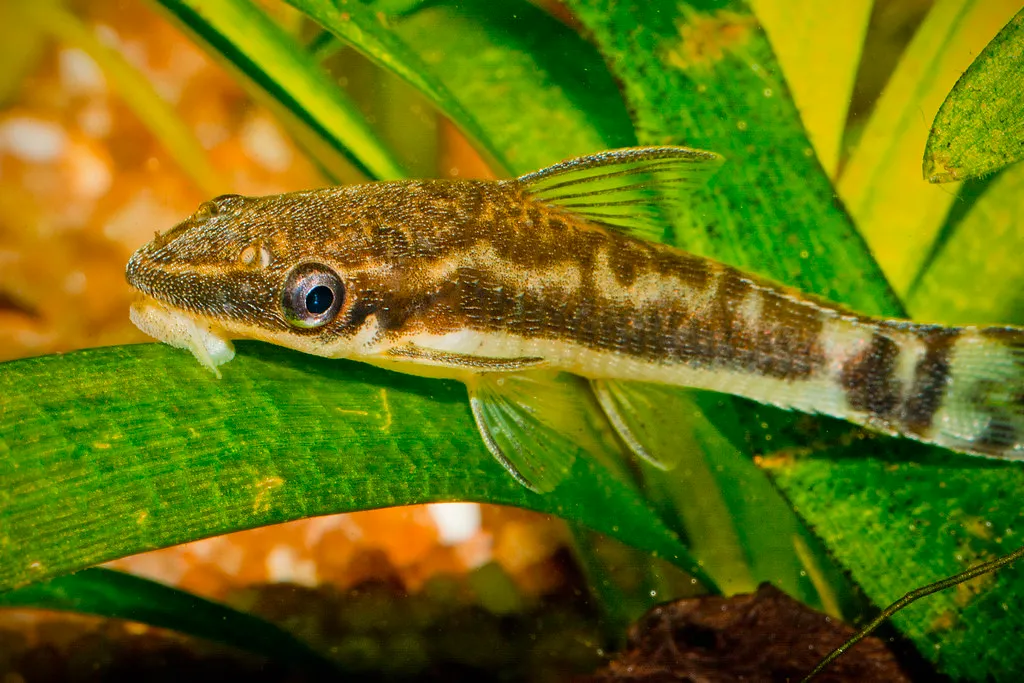
| Category | Details |
| Physical Characteristics | These small catfish typically reach a size of around 1.5-2 inches and have a distinctive appearance with their sucker-shaped mouth and streamlined body. |
| Behavior and Temperament | Otocinclus Catfish are peaceful and highly social. They are known for their algae-cleaning behavior, making them beneficial for the overall tank environment. |
| Water Parameter Compatibility | They thrive in slightly acidic to neutral pH (6.0-7.5) waters and a temperature range of 74-78°F, aligning well with the requirements of Glowlight Tetras. |
| Dietary Needs | Their primary diet consists of algae and biofilm in the aquarium. It’s important to supplement their diet with algae wafers or blanched vegetables as well. |
| Tank Size and Grouping | A tank of 20 gallons or more is suitable for a group of Otocinclus Catfish. They prefer being in groups, and having multiple Otos adds to their activity and comfort. |
| Visual Appeal and Community Dynamics | Otocinclus Catfish contribute to a cleaner tank by controlling algae growth, and their small, sleek appearance adds visual interest to the tank. |
| Compatibility Considerations | Their peaceful and algae-eating nature makes them excellent companions for Glowlight Tetras, creating a harmonious and visually appealing aquatic community. |
Panda Corydoras
Panda Corydoras, scientifically named Corydoras panda, are highly popular as tank mates for Glowlight Tetras, known for their striking black and white coloration.
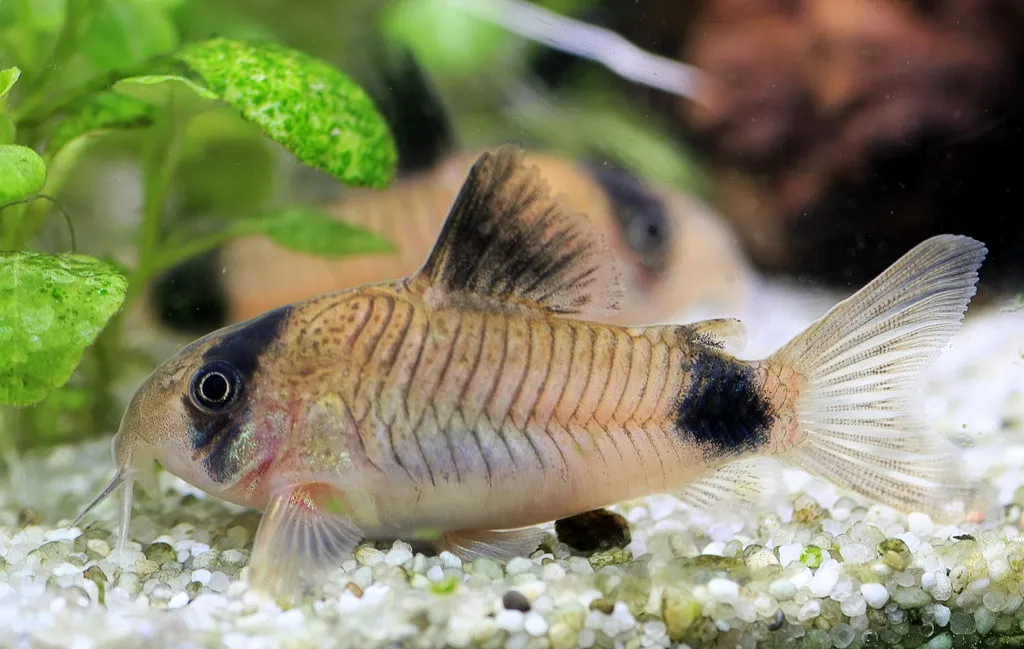
| Category | Details |
| Physical Characteristics | These small catfish usually reach a size of about 1.5-2 inches and are characterized by their panda-like black patches over a white or light-colored body. |
| Behavior and Temperament | Panda Corydoras are peaceful and social bottom-dwelling fish. They display active and playful behavior, adding vitality to the lower levels of the aquarium. |
| Water Parameter Compatibility | They prefer soft to slightly hard water with a pH range of 6.0-7.5 and a temperature range of 72-78°F (22-26°C), aligning well with the requirements of Glowlight Tetras. |
| Dietary Needs | Their diet consists of sinking pellets, flakes, and occasional live or frozen foods. They are omnivores and will consume a variety of foods, including algae wafers. |
| Tank Size and Grouping | A tank of 20 gallons or more is suitable for a group of Panda Corydoras. They thrive in groups, and having multiple individuals enhances their social dynamics. |
| Visual Appeal and Community Dynamics | Panda Corydoras with their distinct coloration and playful behavior add visual appeal and liveliness to the tank, making them excellent companions for Glowlight Tetras. |
| Compatibility Considerations | Their peaceful nature and preference for the lower tank levels make them compatible and engaging tank mates for the active and mid-level swimmers like Glowlight Tetras. |
Pygmy Corydoras
Pygmy Corydoras, scientifically known as Corydoras pygmaeus, are a favored choice as tank mates for Glowlight Tetras due to their small size and peaceful nature.
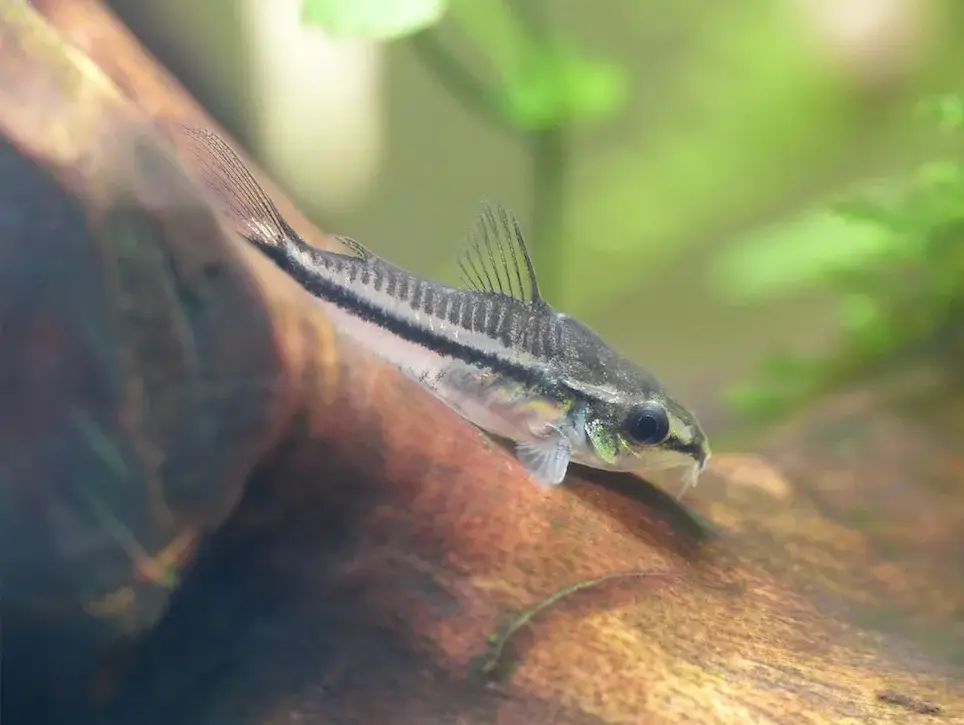
| Category | Details |
| Physical Characteristics | These tiny catfish typically reach a size of around 1 inch and have a slender body with distinct dark lateral stripes running along their length. |
| Behavior and Temperament | Pygmy Corydoras are peaceful, active, and sociable fish. They tend to stick together and often shoal, adding a lively dynamic to the lower levels of the aquarium. |
| Water Parameter Compatibility | They prefer slightly acidic to neutral pH (6.0-7.5) waters and a temperature range of 72-78°F, aligning well with the requirements of Glowlight Tetras. |
| Dietary Needs | Their diet primarily consists of sinking pellets, flakes, and occasional live or frozen foods. They are not picky eaters and will readily accept a variety of foods. |
| Tank Size and Grouping | A tank of 10 gallons or more is suitable for a group of Pygmy Corydoras. They prefer being in groups, and having multiple Pygmy Corydoras enhances their well-being. |
| Visual Appeal and Community Dynamics | Pygmy Corydoras’ small size and charming behavior contribute to the visual appeal of the tank. They coexist peacefully with Glowlight Tetras, creating a serene ambiance. |
| Compatibility Considerations | Their peaceful nature and small size make them excellent companions for Glowlight Tetras, enhancing the overall visual and social dynamics of the aquarium. |
Sterbai Corydoras
Sterbai Corydoras, scientifically known as Corydoras sterbai, are prized tank mates for Glowlight Tetras due to their striking appearance and peaceful demeanor.
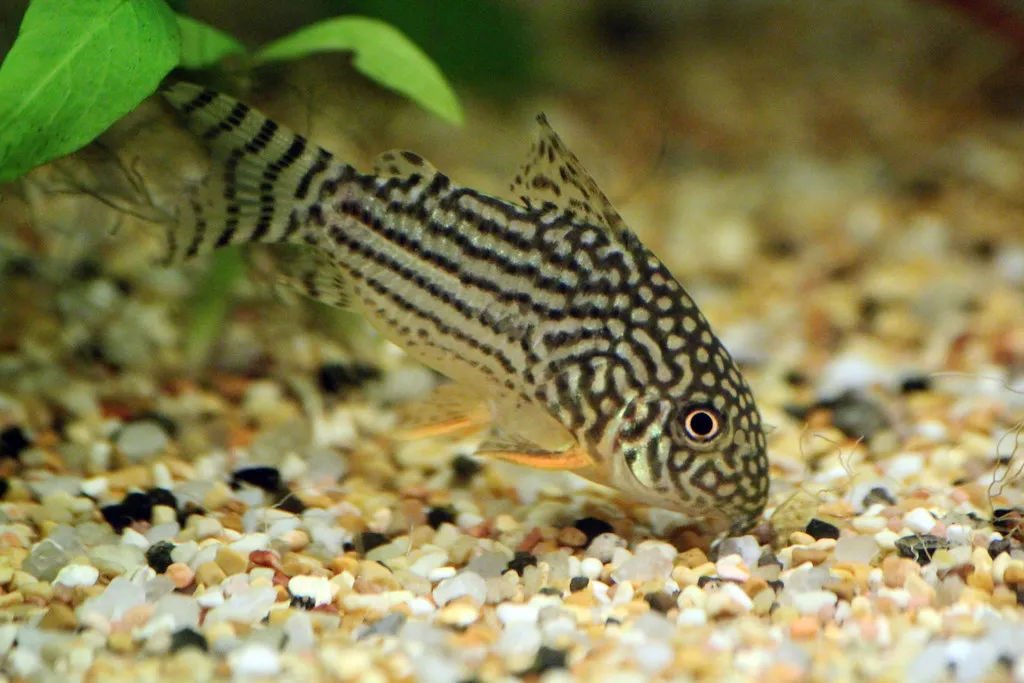
| Category | Details |
| Physical Characteristics | These small catfish typically reach a size of around 2.5 inches and boast a unique pattern with orange, brown, and black patches covering their bronze-colored body. |
| Behavior and Temperament | Sterbai Corydoras are peaceful bottom-dwelling fish known for their social behavior. They are active during the day and prefer being in groups, enhancing tank dynamics. |
| Water Parameter Compatibility | They prefer slightly acidic to neutral pH (6.0-7.5) waters and a temperature range of 75-80°F, aligning well with the requirements of Glowlight Tetras. |
| Dietary Needs | Their diet primarily includes sinking pellets, flakes, and occasional live or frozen foods. They are not aggressive feeders, ensuring ample food for Glowlight Tetras. |
| Tank Size and Grouping | A tank of 20 gallons or more is suitable for a group of Sterbai Corydoras. They thrive in groups and exhibit more natural behaviors in a well-populated environment. |
| Visual Appeal and Community Dynamics | Sterbai Corydoras add visual appeal with their unique coloration and active bottom-dwelling behavior. They coexist harmoniously, creating a visually attractive community. |
| Compatibility Considerations | Their peaceful nature and bottom-dwelling behavior make Sterbai Corydoras ideal companions for Glowlight Tetras, contributing to a vibrant and harmonious aquarium. |
Bristlenose Pleco
Bristlenose Plecos (Ancistrus sp.) are widely chosen as tank mates for Glowlight Tetras due to their algae-eating abilities and peaceful nature.
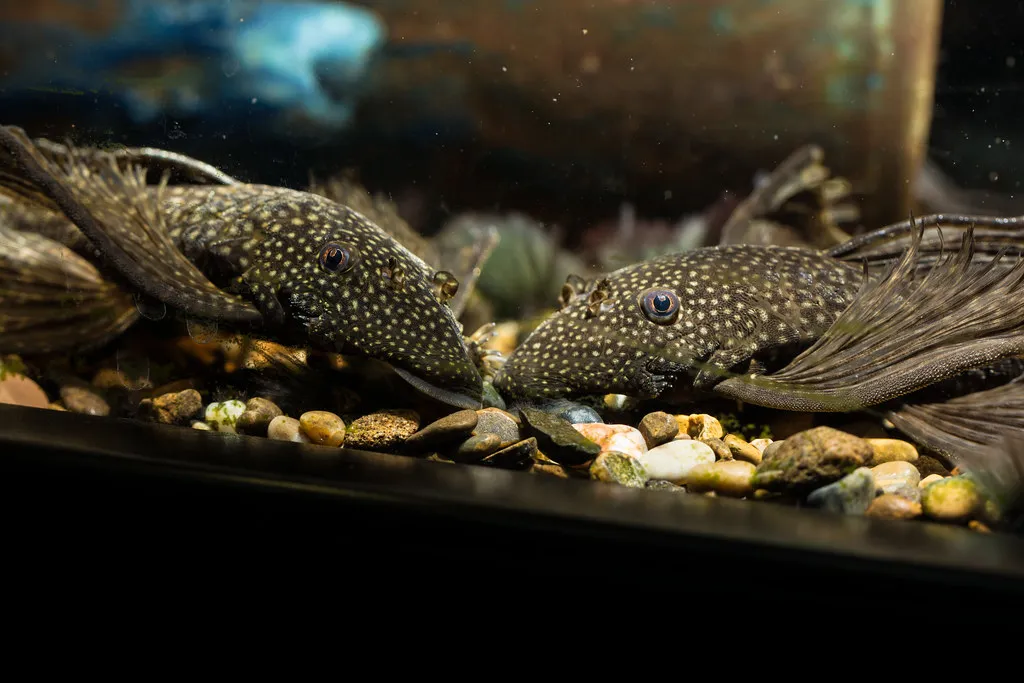
| Category | Details |
| Physical Characteristics | These small catfish usually reach a size of around 4-6 inches. They have a distinctive appearance with “bristles” or tentacles on their snouts, more prominent in males. |
| Behavior and Temperament | Bristlenose Plecos are peaceful and nocturnal. They spend their days hiding and become active at night. They are generally compatible and non-aggressive towards other fish. |
| Water Parameter Compatibility | They prefer slightly acidic to neutral pH (6.0-7.5) and a temperature range of 60-80°F (15-27°C), making them adaptable and suitable tank mates for Glowlight Tetras. |
| Dietary Needs | Bristlenose Plecos are herbivores and primarily feed on algae. Providing algae wafers and occasional blanched vegetables like zucchini or spinach ensures a well-rounded diet. |
| Tank Size and Grouping | A 25-gallon tank or larger is appropriate for a single Bristlenose Pleco. They are territorial, so avoid overcrowding. They can be kept singly or in pairs in a larger tank. |
| Visual Appeal and Community Dynamics | Bristlenose Plecos have a unique appearance with bristle-like projections on their heads, adding a distinctive look to the aquarium. They are peaceful and coexist well with Tetras. |
| Compatibility Considerations | Bristlenose Plecos are compatible with Glowlight Tetras due to their peaceful nature and algae-eating habits, contributing to a clean and visually appealing aquatic environment. |
Zebra Pleco
Zebra Plecos (Hypancistrus zebra) are a popular choice as tank mates for Glowlight Tetras due to their captivating appearance and compatibility with community aquariums.
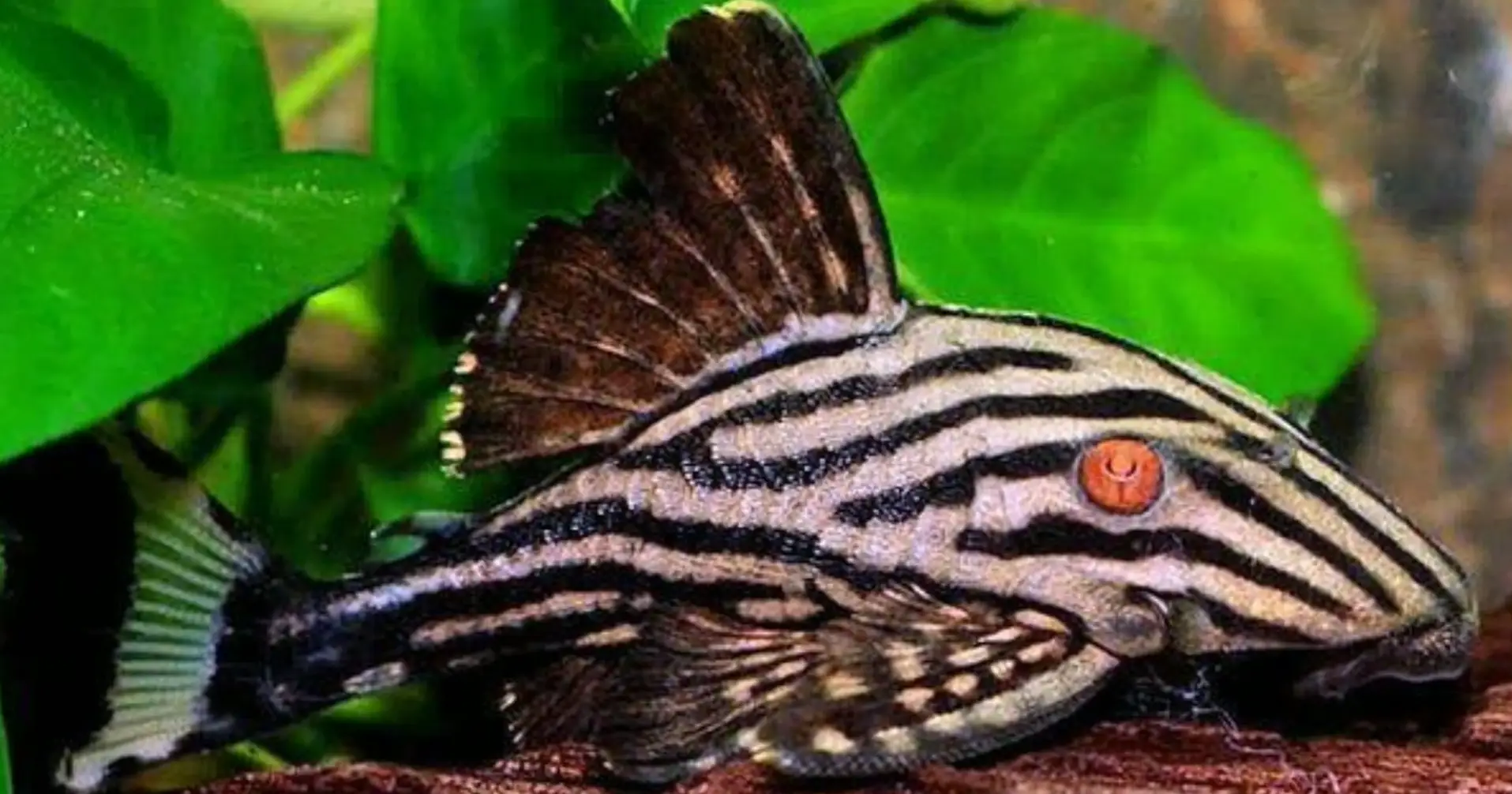
| Category | Details |
| Physical Characteristics | Zebra Plecos are small catfish known for their striking black and white striped patterns, resembling a zebra. They typically grow to around 3-4 inches. |
| Behavior and Temperament | These catfish are generally peaceful but can display territorial behavior. They are nocturnal and prefer hiding in caves or crevices during the day. |
| Water Parameter Compatibility | Zebra Plecos thrive in slightly acidic to neutral pH (6.0-7.0) waters and a temperature range of 78-86°F, aligning well with the conditions suitable for Glowlight Tetras. |
| Dietary Needs | Their diet mainly comprises algae, sinking pellets, and occasional live or frozen foods. Ensuring a balanced nutritional intake is essential for their well-being. |
| Tank Size and Grouping | A minimum tank size of 30 gallons is recommended for Zebra Plecos. They are solitary and territorial, so it’s advisable to keep one per tank, unless the tank is very spacious. |
| Visual Appeal and Community Dynamics | Zebra Plecos contribute to the visual appeal of the tank with their distinct patterns. However, they are primarily nocturnal and tend to hide during the day, limiting their visibility and community interactions. |
| Compatibility Considerations | Zebra Plecos can coexist with Glowlight Tetras due to their peaceful nature. However, their nocturnal behavior may reduce the vibrant community dynamics typically seen with other diurnal tank mates. |
Cichlid
Cichlids can be colorful and vibrant, but choosing the right ones is key. Opt for peaceful cichlid species like Bolivian Ram Cichlid to keep the harmony with your glowlight tetras.
Bolivian Ram Cichlid
Bolivian Ram Cichlids, scientifically known as Mikrogeophagus altispinosus, make excellent tank mates for Glowlight Tetras, bringing color and activity to the aquarium.
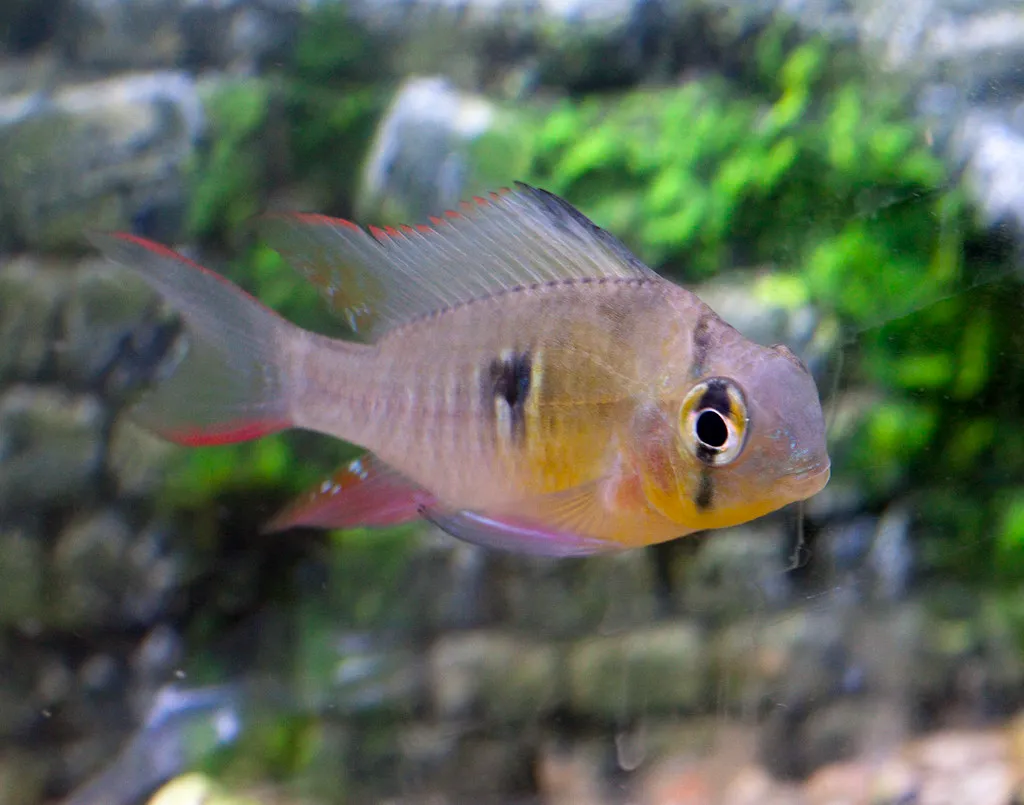
| Category | Details |
| Physical Characteristics | Bolivian Rams have a distinct golden-yellow hue and red eyes. They typically grow to about 3 inches in size, displaying unique patterns and a peaceful demeanor. |
| Behavior and Temperament | These cichlids are peaceful and non-aggressive, making them compatible with the gentle nature of Glowlight Tetras. They add vibrancy and interest to the tank. |
| Water Parameter Compatibility | They prefer slightly acidic to neutral pH (6.0-7.5) waters and a temperature range of 75-84°F, aligning well with the preferences of Glowlight Tetras. |
| Dietary Needs | Bolivian Ram Cichlids are omnivores, enjoying a diet of pellets, flakes, small live or frozen foods. Their varied diet ensures they won’t compete heavily with Tetras. |
| Tank Size and Grouping | A tank of 30 gallons or more is recommended for a pair or a small group of Bolivian Rams. They can be territorial, so providing adequate space is important for harmony. |
| Visual Appeal and Community Dynamics | Bolivian Rams add visual appeal with their colors and distinctive behaviors. They interact well with Tetras, creating a captivating and lively aquatic community. |
| Compatibility Considerations | Due to their peaceful nature and compatibility with community tanks, Bolivian Ram Cichlids are ideal tank mates for Glowlight Tetras, enhancing the overall tank dynamics. |
Danio
Danios are active and lively, adding energy to your tank. Zebra Danios, for example, are known for their striking stripes and friendly temperament, making them great companions.
Celestial Pearl Danio
Celestial Pearl Danios, scientifically known as Celestichthys margaritatus, are popular tank mates for Glowlight Tetras, known for their vibrant colors and peaceful nature.
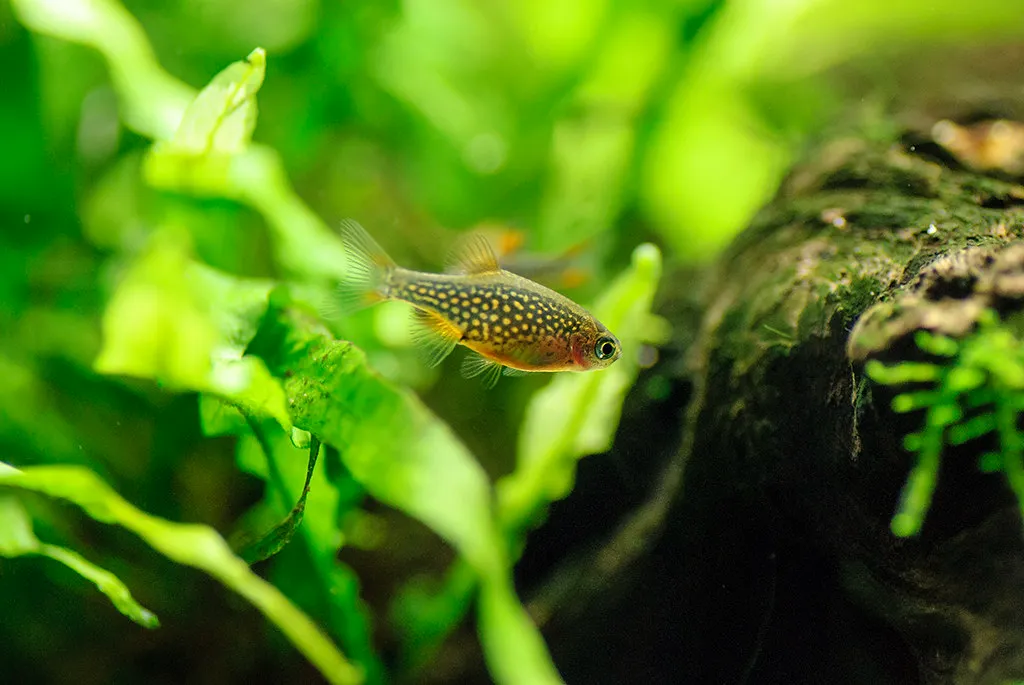
| Category | Details |
| Physical Characteristics | These danios are small, reaching about 1 inch in size. They are adorned with striking colors, resembling pearls and galaxies. Their vibrant appearance adds allure to any aquarium. |
| Behavior and Temperament | Celestial Pearl Danios are peaceful and active swimmers, complementing the schooling behavior of Glowlight Tetras. They add energy and liveliness to the mid and upper levels of the tank. |
| Water Parameter Compatibility | They prefer slightly acidic to neutral pH (6.5-7.5) and a temperature range of 73-79°F, which aligns well with the conditions preferred by Glowlight Tetras. |
| Dietary Needs | Celestial Pearl Danios are omnivores, enjoying a diet of flakes, micro pellets, and occasional live or frozen foods. Their diet closely matches that of Glowlight Tetras, ensuring easy feeding. |
| Tank Size and Grouping | A tank of 10 gallons or more is suitable for a small school of Celestial Pearl Danios. They thrive in groups and having a school creates a visually pleasing and dynamic aquatic environment. |
| Visual Appeal and Community Dynamics | Celestial Pearl Danios are captivating with their pearl-like colors and active swimming. They exhibit peaceful interactions, enhancing the overall aesthetics of a community tank. |
| Compatibility Considerations | Due to their peaceful and schooling nature, Celestial Pearl Danios coexist harmoniously with Glowlight Tetras, creating an engaging and colorful aquarium scene. |
Zebra Danio
Zebra Danios, scientifically known as Danio rerio, are popular and energetic tank mates for Glowlight Tetras. Known for their distinctive zebra-like stripes, they add liveliness to the tank.
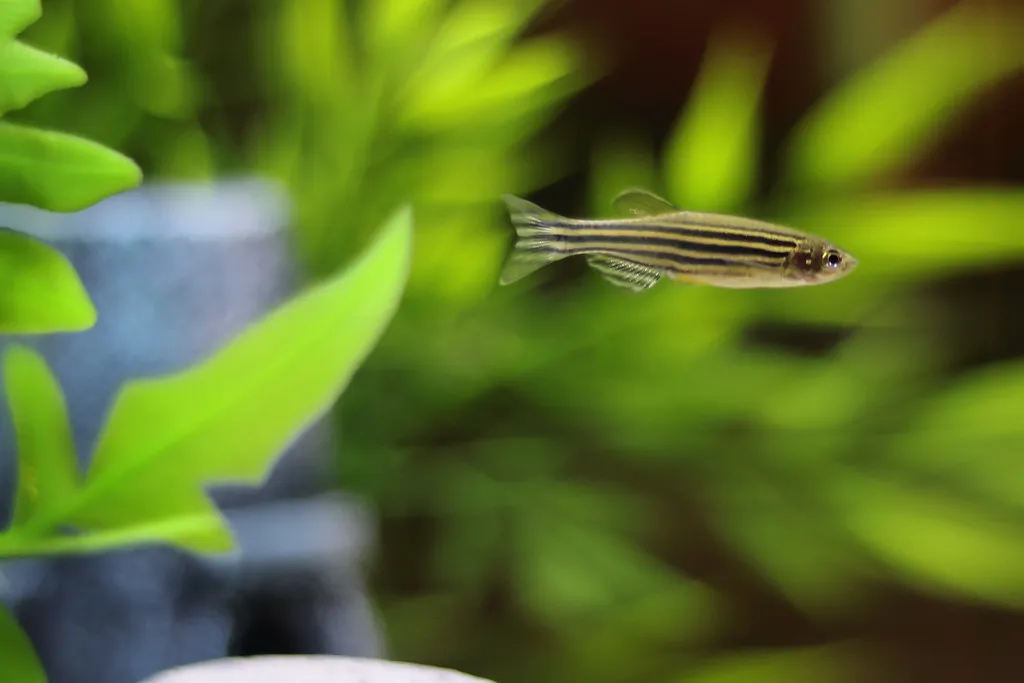
| Category | Details |
| Physical Characteristics | Zebra Danios are small, typically reaching around 2 inches in size. They have a streamlined body with bold, horizontal black stripes resembling a zebra, making them visually striking. |
| Behavior and Temperament | These danios are active and social, often seen swimming rapidly throughout the tank. They exhibit a schooling behavior, providing a dynamic and lively atmosphere in the upper levels of the tank. |
| Water Parameter Compatibility | They thrive in slightly acidic to slightly alkaline pH (6.5-7.5) and a temperature range of 64-77°F, aligning well with the conditions preferred by Glowlight Tetras. |
| Dietary Needs | Zebra Danios are omnivores and have a hearty appetite. They enjoy various foods, including flakes, pellets, brine shrimp, and worms, making feeding them alongside Glowlight Tetras convenient. |
| Tank Size and Grouping | A tank of 20 gallons or more is ideal for a group of Zebra Danios. They prefer being in groups of at least 6 individuals, creating an active and visually appealing display within the aquarium. |
| Visual Appeal and Community Dynamics | Zebra Danios’ unique stripes and energetic swimming patterns add a captivating contrast to the tank’s aesthetics. Their schooling behavior enhances the community dynamics in the aquarium. |
| Compatibility Considerations | Due to their peaceful and schooling nature, Zebra Danios are excellent companions for Glowlight Tetras. They coexist well, showcasing a lively and visually appealing underwater environment. |
Gourami
Gouramis come in various colors and sizes. From the stunning Dwarf Gourami to the graceful Pearl Gourami, there’s a gourami for every tank with glowlight tetras.
Dwarf Gourami
Dwarf Gouramis (Trichogaster lalius) are vibrant, small-sized labyrinth fish that make eye-catching tank mates for Glowlight Tetras. Their colorful and peaceful nature adds charm to the tank.
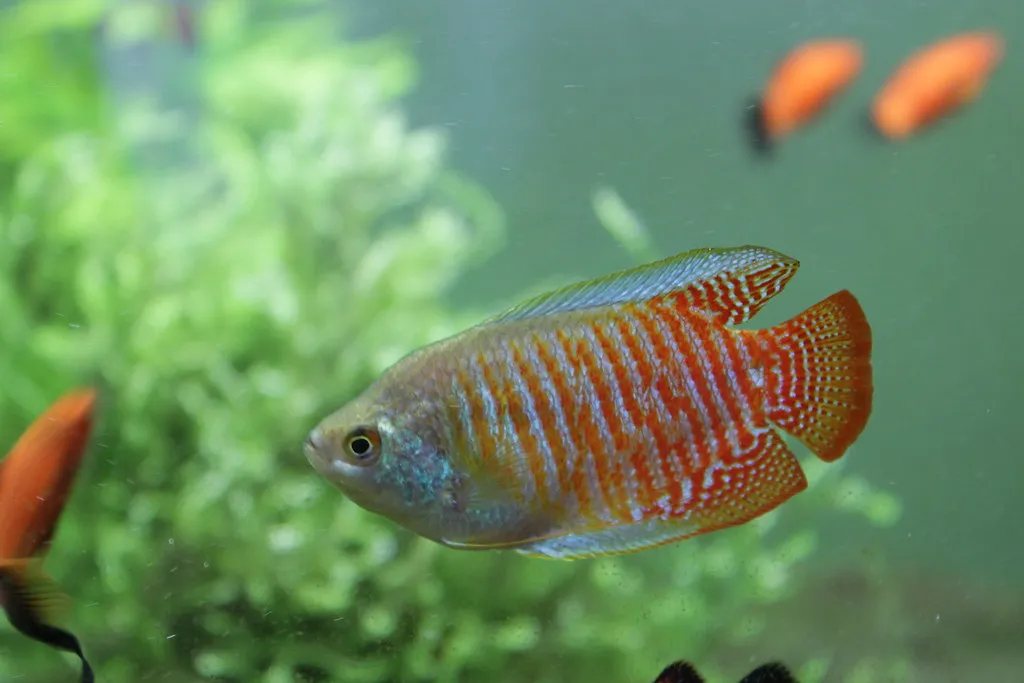
| Category | Details |
| Physical Characteristics | Dwarf Gouramis are small, usually growing up to 2 inches. They come in various color variations, including red, blue, and flame, showcasing beautiful patterns and enhancing the aquarium’s aesthetics. |
| Behavior and Temperament | Known for their peaceful demeanor, Dwarf Gouramis are relatively calm fish. They enjoy spending time in the mid to top levels of the tank, and their graceful movements complement the tank’s liveliness. |
| Water Parameter Compatibility | They prefer slightly acidic to slightly alkaline pH (6.0-7.5) and a temperature range of 72-82°F, aligning well with the conditions preferred by Glowlight Tetras. |
| Dietary Needs | Dwarf Gouramis are omnivores, enjoying a varied diet. They consume flakes, pellets, freeze-dried, and frozen foods. Ensuring a balanced diet is crucial for their health and compatibility with other fish. |
| Tank Size and Grouping | A 20-gallon tank or more is suitable for a pair or a small group of Dwarf Gouramis. They are generally solitary fish, and if kept in pairs, ensure adequate hiding spots and visual barriers for them. |
| Visual Appeal and Community Dynamics | Dwarf Gouramis’ vibrant colors and graceful movements make them attractive additions to a tank. Their calm nature makes them compatible, creating a visually appealing and peaceful aquatic community. |
| Compatibility Considerations | Due to their peaceful temperament and compatibility with various fish species, Dwarf Gouramis can coexist harmoniously with Glowlight Tetras, contributing to a vibrant and visually appealing aquarium. |
Honey Gourami
Honey Gouramis (Trichogaster chuna), also known as Sunset Gouramis, are peaceful, small labyrinth fish known for their vibrant golden-orange coloration, making them attractive tank mates.
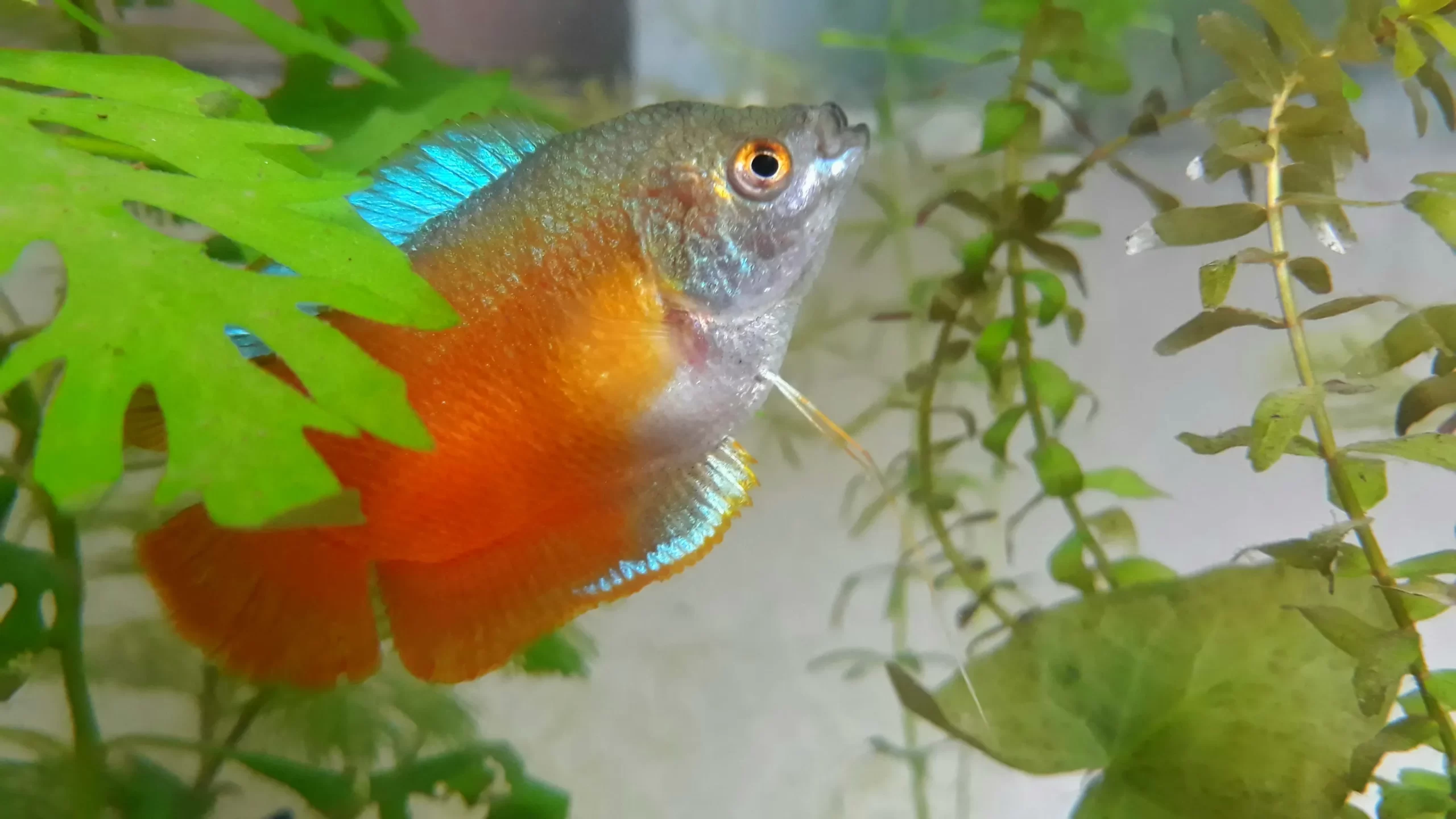
| Category | Details |
| Physical Characteristics | Honey Gouramis are small, usually growing up to 2-3 inches. They have a distinctive honey or amber coloration, enhancing the visual appeal of the tank. |
| Behavior and Temperament | Known for their peaceful and shy demeanor, Honey Gouramis prefer the mid to top levels of the tank. They are social and can be kept in pairs, adding a tranquil vibe to the aquarium. |
| Water Parameter Compatibility | They prefer slightly acidic to slightly alkaline pH (6.0-7.5) and a temperature range of 75-82°F, aligning well with the conditions preferred by Glowlight Tetras. |
| Dietary Needs | Honey Gouramis are omnivores, enjoying a varied diet. They consume flakes, pellets, freeze-dried, and frozen foods. A balanced diet contributes to their vibrant coloration and health. |
| Tank Size and Grouping | A 20-gallon tank or more is suitable for a pair or a small group of Honey Gouramis. They thrive in a planted tank with gentle filtration and plenty of hiding spots and aquatic plants. |
| Visual Appeal and Community Dynamics | Honey Gouramis’ golden hue adds an elegant touch to an aquarium. Their peaceful nature and compatibility with various fish make them ideal tank mates, enhancing the overall aesthetics. |
| Compatibility Considerations | Due to their peaceful temperament, Honey Gouramis coexist harmoniously with Glowlight Tetras, creating a visually appealing and peaceful aquatic community in the home aquarium. |
Pearl Gourami
Pearl Gouramis (Trichogaster leeri), known for their pearly scales and captivating appearance, are a popular choice as tank mates due to their peaceful temperament and beauty.
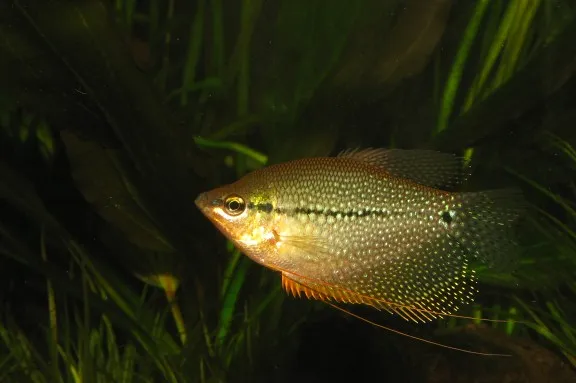
| Category | Details |
| Physical Characteristics | Pearl Gouramis are medium-sized, usually growing up to 4-5 inches. They have a distinct silvery-gold body adorned with pearly spots, resembling shimmering pearls. |
| Behavior and Temperament | They are calm and peaceful, often occupying the middle and top areas of the tank. They are social and can be kept in pairs or small groups, adding grace and tranquility to the tank. |
| Water Parameter Compatibility | They prefer slightly acidic to slightly alkaline pH (6.0-7.5) and a temperature range of 75-82°F, aligning well with the conditions preferred by Glowlight Tetras. |
| Dietary Needs | Pearl Gouramis are omnivores. Their diet includes flakes, pellets, live or frozen foods like brine shrimp or bloodworms. A varied diet ensures their vibrant colors and good health. |
| Tank Size and Grouping | A 30-gallon tank or larger is suitable for a pair or a small group of Pearl Gouramis. They appreciate planted tanks with ample swimming space and peaceful tank mates. |
| Visual Appeal and Community Dynamics | The iridescent pearly spots on their body create a mesmerizing display. Their peaceful nature and compatibility with various fish make them ideal tank mates, enhancing the aesthetics. |
| Compatibility Considerations | Pearl Gouramis coexist harmoniously with Glowlight Tetras due to their calm temperament. Together, they create a visually appealing and tranquil aquatic community within the tank. |
Sparkling Gourami
Sparkling Gouramis (Trichopsis pumila), also known as Pygmy Gouramis, are small, peaceful fish known for their sparkling scales and unique behavior.
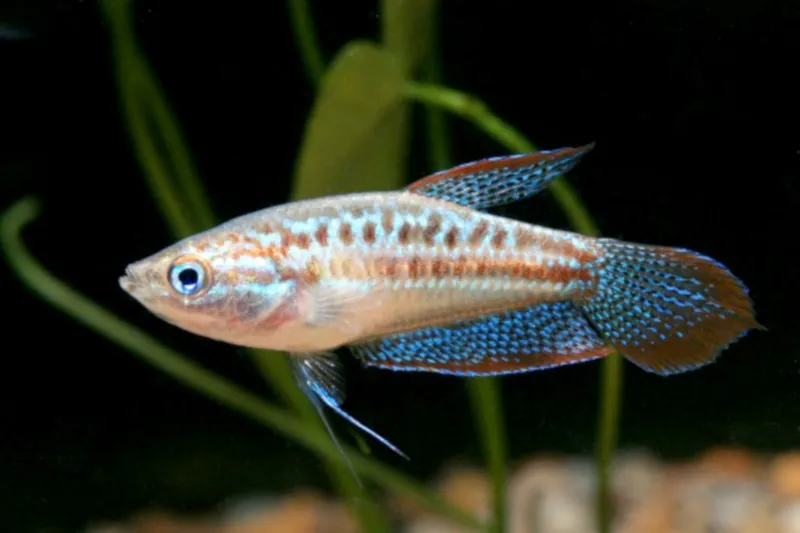
| Category | Details |
| Physical Characteristics | These gouramis are small, usually around 1.5 inches in size. They have a silvery body adorned with iridescent, sparkly scales, resembling a starry night sky. |
| Behavior and Temperament | They are peaceful, curious, and active swimmers, often occupying the upper levels of the tank. They coexist well with other peaceful tank mates, including Tetras. |
| Water Parameter Compatibility | They prefer slightly acidic to slightly alkaline pH (6.0-7.5) and a temperature range of 72-82°F, aligning well with the conditions preferred by Glowlight Tetras. |
| Dietary Needs | Sparkling Gouramis are omnivores, enjoying a varied diet that includes flakes, small pellets, live or frozen foods like brine shrimp or daphnia. |
| Tank Size and Grouping | A 10-gallon tank or larger is suitable for a small group of Sparkling Gouramis. They appreciate densely planted tanks with gentle filtration and subdued lighting. |
| Visual Appeal and Community Dynamics | Their sparkling scales create a captivating visual display. Their peaceful nature and small size make them excellent tank mates, enhancing the overall aquarium ambiance. |
| Compatibility Considerations | Sparkling Gouramis coexist harmoniously with Glowlight Tetras due to their calm and peaceful temperament. They contribute to a visually appealing and serene aquatic community. |
Livebearers
Livebearers like guppies and mollies can coexist peacefully with glowlight tetras. Their vibrant colors and active nature make for an engaging aquatic community.
Guppies
Guppies (Poecilia reticulata) are one of the most popular and colorful freshwater fish in the aquarium hobby, known for their vibrant hues and lively nature.
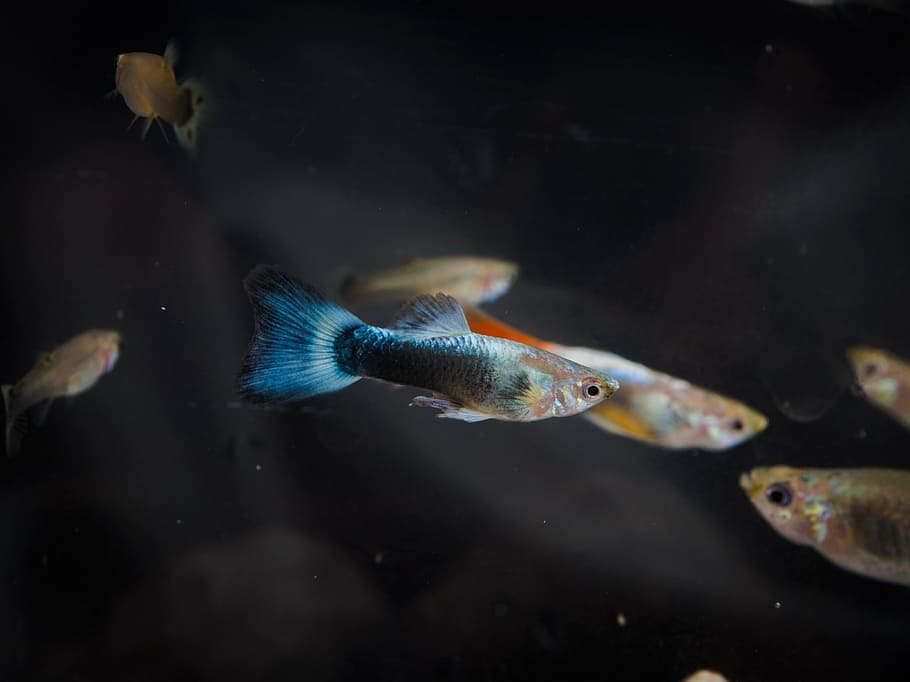
| Category | Details |
| Physical Characteristics | Guppies are small, usually around 2 inches in size. They come in a wide range of colors and patterns, making them visually striking and appealing to aquarium owners. |
| Behavior and Temperament | They are active, social, and peaceful fish, making them compatible with various community tank mates, including Glowlight Tetras. They enjoy swimming in the upper levels. |
| Water Parameter Compatibility | Guppies prefer slightly alkaline to slightly acidic pH (6.8-7.6) and a temperature range of 72-82°F, aligning well with the conditions preferred by Glowlight Tetras. |
| Dietary Needs | Guppies are omnivores and enjoy a diet consisting of flakes, pellets, live or frozen foods like brine shrimp or daphnia, and occasional vegetable matter for fiber. |
| Tank Size and Grouping | A 10-gallon tank or larger is suitable for a small group of guppies. They thrive in groups and appreciate a well-planted tank with ample swimming space. |
| Visual Appeal and Community Dynamics | Guppies add vibrant colors and energetic movement to the tank, enhancing the visual appeal. Their peaceful nature and lively behavior make them great tank mates for Tetras. |
| Compatibility Considerations | Guppies are compatible with Glowlight Tetras due to their peaceful temperament and similar water parameter preferences. Together, they create an attractive and lively aquarium. |
Mollies
Mollies are freshwater fish (Poecilia sp.) known for their lively behavior and various color variations. They are a popular choice among aquarium hobbyists.
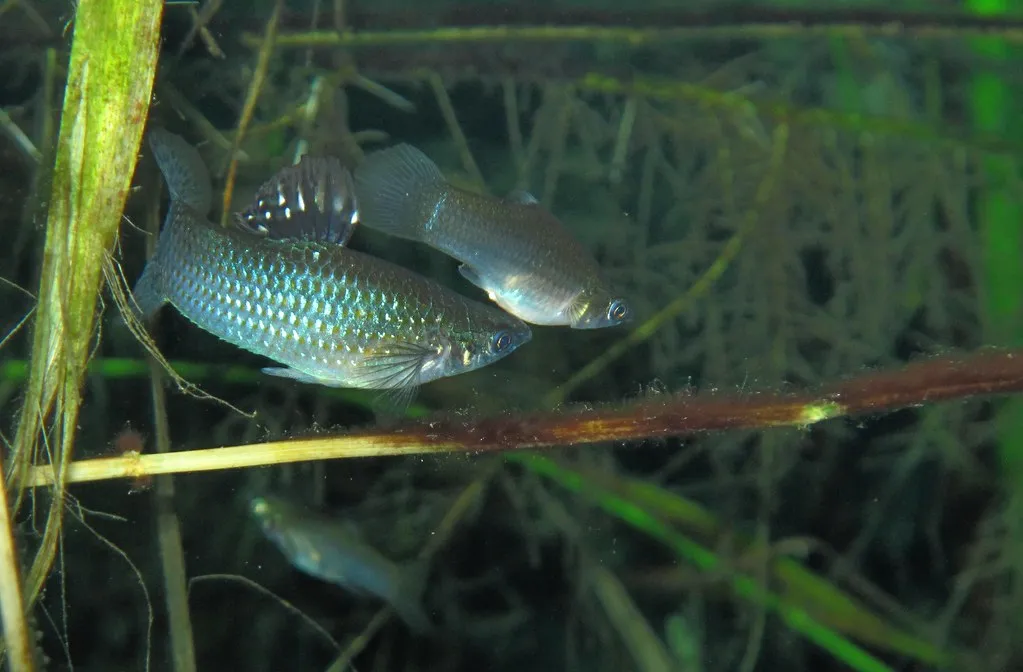
| Category | Details |
| Physical Characteristics | Mollies come in various colors, including black, white, orange, and more. They have a distinct sailfin dorsal fin and can grow to about 3-5 inches in length. |
| Behavior and Temperament | They are generally peaceful but can be somewhat territorial. They prefer swimming in the middle and top areas of the tank. They are social and enjoy company. |
| Water Parameter Compatibility | Mollies prefer a slightly alkaline to slightly acidic pH (7.0-7.8) and a temperature range of 72-78°F, which is compatible with the requirements of Glowlight Tetras. |
| Dietary Needs | Mollies are omnivores, needing a balanced diet of flakes, pellets, and occasional live or frozen foods like brine shrimp. They also benefit from some plant matter. |
| Tank Size and Grouping | A 20-gallon tank or larger is suitable for a small group of mollies. They prefer being in groups, and the tank should have some plants and open swimming areas. |
| Visual Appeal and Community Dynamics | Mollies add variety to the tank with their colors and active swimming. They coexist well with Tetras and other community fish, enhancing the overall aquarium dynamics. |
| Compatibility Considerations | Mollies are compatible with Glowlight Tetras, provided the tank has ample space and appropriate water conditions. Their peaceful nature makes them good tank mates. |
Platies
Platies (Xiphophorus maculatus) are colorful and easy-to-care-for freshwater fish. They are popular among beginners and come in various vibrant colors and patterns.
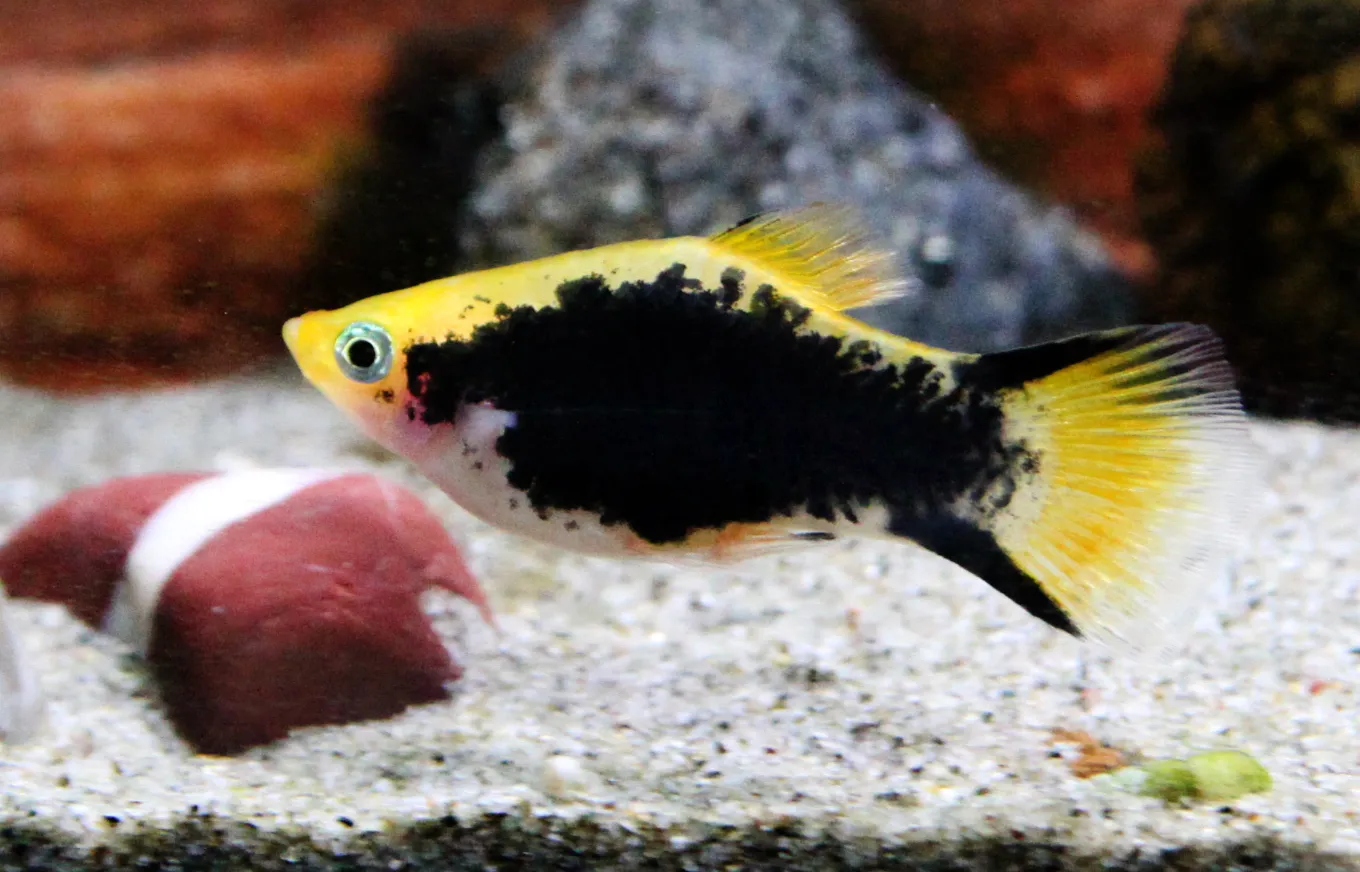
| Category | Details |
| Physical Characteristics | Platies have a broad, somewhat oval-shaped body and fins of various colors. They typically grow to about 2-3 inches in length, depending on the specific variety. |
| Behavior and Temperament | They are peaceful and sociable, making them excellent community fish. Platies enjoy swimming in the middle and top levels of the tank and exhibit active behavior. |
| Water Parameter Compatibility | Platies prefer a slightly alkaline to slightly acidic pH (7.0-8.0) and a temperature range of 70-78°F, which aligns well with the requirements of Glowlight Tetras. |
| Dietary Needs | Platies are omnivores and enjoy a diet of flakes, pellets, and occasional live or frozen foods like brine shrimp. They also benefit from some vegetable matter. |
| Tank Size and Grouping | A 10-gallon tank or larger is suitable for a small group of platies. They prefer being in groups and thrive in a well-planted tank with plenty of swimming space. |
| Visual Appeal and Community Dynamics | Platies add color and lively activity to the tank, enhancing its visual appeal. They are compatible with Tetras and other community fish, creating an engaging aquarium. |
| Compatibility Considerations | Platies are compatible with Glowlight Tetras, given a sufficiently sized tank and similar water conditions. Their peaceful nature makes them good companions for Tetras. |
Swordtail
Swordtails (Xiphophorus hellerii) are popular and colorful freshwater fish known for the distinctive elongated lower lobe on their caudal fin, resembling a sword, hence their name.
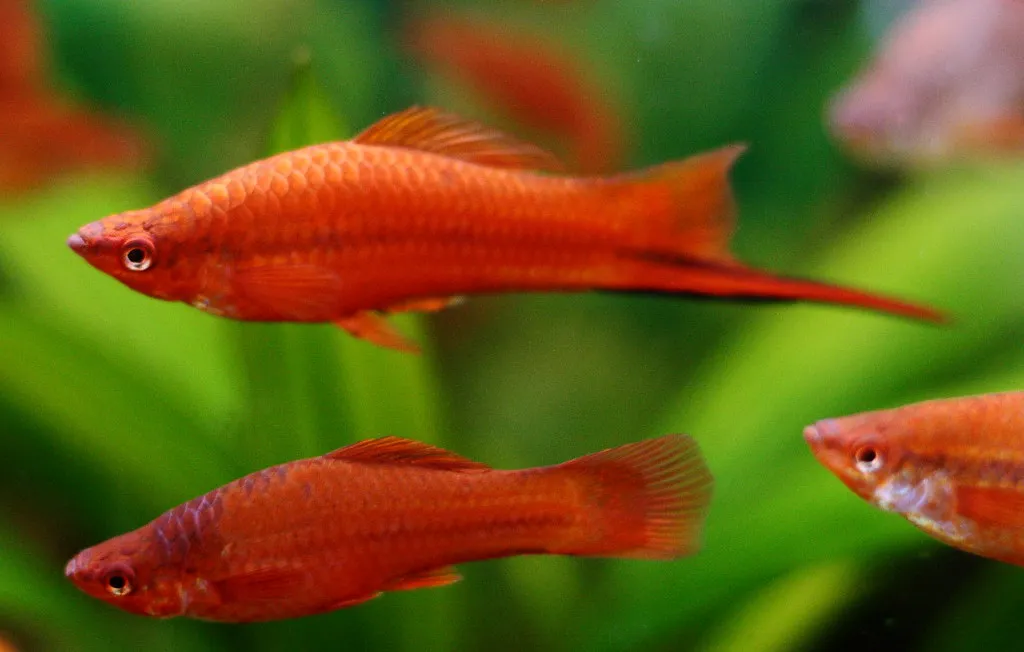
| Category | Details |
| Physical Characteristics | Swordtails have a sleek body and, as the name suggests, a sword-like extension on their caudal fin. They come in various colors and patterns, making them visually captivating in the aquarium. |
| Behavior and Temperament | They are generally peaceful, active fish that enjoy swimming in the middle and top levels of the tank. They are compatible with other community fish, including Glowlight Tetras. |
| Water Parameter Compatibility | Swordtails prefer a slightly alkaline to neutral pH (7.0-8.4) and a temperature range of 72-82°F, aligning well with the conditions preferred by Glowlight Tetras. |
| Dietary Needs | Swordtails are omnivores and enjoy a varied diet including flakes, pellets, frozen or live foods like brine shrimp, and occasionally, vegetable matter for a balanced diet. |
| Tank Size and Grouping | A 30-gallon tank or larger is ideal for a small group of swordtails. They thrive in groups and appreciate well-planted tanks with ample swimming space and hiding spots. |
| Visual Appeal and Community Dynamics | Swordtails add vibrant colors and dynamic movement to the tank, especially males with their sword-like tails. They can coexist peacefully with Glowlight Tetras, creating an appealing aquatic display. |
| Compatibility Considerations | Swordtails’ peaceful temperament and similar water parameter preferences make them compatible with Glowlight Tetras, contributing to an attractive and harmonious community aquarium. |
Loaches
Loaches, such as Kuhli Loach and Clown Loach, are fascinating bottom-dwellers. They’re not only unique to observe but also contribute to a dynamic tank environment.
Clown Loach
The Clown Loach (Chromobotia macracanthus), known for its vibrant colors and playful behavior, is a popular choice among freshwater aquarium enthusiasts. They are social and best kept in groups, adding a lively element to the aquarium.
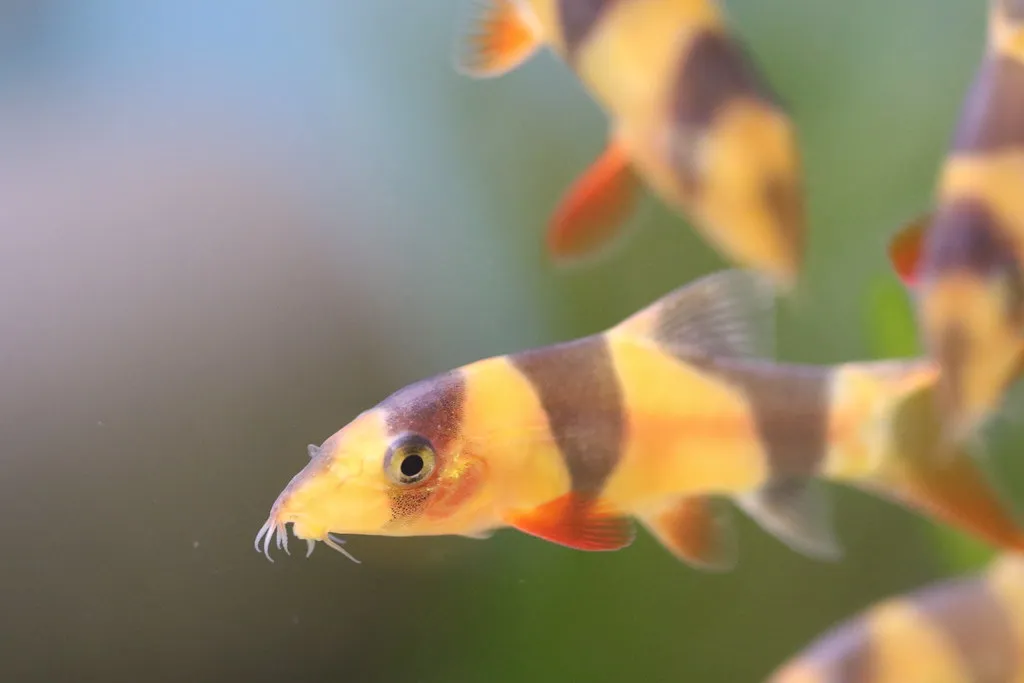
| Category | Details |
| Physical Characteristics | Clown Loaches have distinct orange-yellow bodies with three black stripes and prominent eyes. They can grow relatively large, reaching up to 12 inches (30 cm) in size, making them a substantial yet stunning addition to the tank. |
| Behavior and Temperament | They are peaceful, social fish that enjoy the company of their own kind. They are active and like to explore the tank, often displaying playful behaviors. They can coexist harmoniously with Glowlight Tetras and other community fish. |
| Water Parameter Compatibility | Clown Loaches prefer slightly acidic to neutral pH (6.0-7.5) and a temperature range of 75-81°F (24-27°C), aligning well with the conditions preferred by Glowlight Tetras. |
| Dietary Needs | They are omnivores and have a varied diet including sinking pellets, flakes, frozen foods, and occasionally, live foods. Providing a diverse diet ensures their health and vitality while reducing competition for food with other tank mates. |
| Tank Size and Grouping | A spacious tank of 75 gallons or more is suitable for a small group of Clown Loaches. They prefer to be in groups and require adequate swimming space. Adding hiding spots and plants replicates their natural habitat and reduces stress. |
| Visual Appeal and Community Dynamics | Clown Loaches introduce vibrant colors and playful behavior to the aquarium. They interact well with Glowlight Tetras, creating an appealing and dynamic community. Their unique appearance and behavior captivate the attention of any onlooker. |
| Compatibility Considerations | Clown Loaches’ peaceful temperament and compatibility with similar water parameters make them excellent tank mates for Glowlight Tetras, enhancing the overall aesthetics and dynamics of the aquarium community. |
Hillstream Loach
Hillstream Loaches, scientifically known as Sewellia lineolata, comprise various species. They are unique with their flattened bodies and adapted to fast-flowing streams. These loaches are intriguing additions for aquarists seeking a distinctive touch.
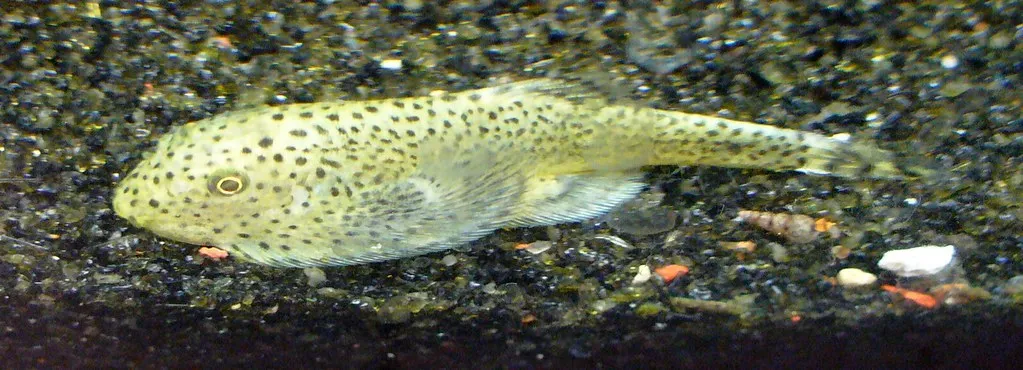
| Category | Details |
| Physical Characteristics | Hillstream Loaches have flattened bodies, ideal for life in fast-flowing waters. Suction-like undersides help them cling to rocks and surfaces. Their appearance includes intricate patterns and shades, adding an interesting dimension to the aquarium. |
| Behavior and Temperament | These loaches are active and prefer strong currents. They can be a bit territorial, especially when establishing their spaces on rocky surfaces. Understanding their behavior helps in creating a well-balanced environment when adding them to the tank. |
| Water Parameter Compatibility | Hillstream Loaches thrive in cooler temperatures, around 72-78°F (22-26°C), and require good water flow in the tank. They prefer a pH range of 6.5-7.5. These conditions should be carefully monitored and replicated to ensure their well-being. |
| Dietary Needs | Hillstream Loaches are primarily herbivores, grazing on algae and biofilm. They will also accept sinking pellets, algae wafers, and occasional treats like bloodworms. A well-rounded diet is essential for their health and growth. |
| Tank Size and Grouping | Given their need for strong currents and ample swimming space, a tank of 30 gallons or more is recommended for a group of Hillstream Loaches. They tend to be more active and comfortable when kept in groups of three or more. |
| Visual Appeal and Community Dynamics | Hillstream Loaches bring a distinctive look to the tank with their flattened bodies and unique movements. They can coexist peacefully with Glowlight Tetras, adding a touch of diversity and intrigue to the aquarium’s dynamics. |
| Compatibility Considerations | Hillstream Loaches, when given the appropriate tank conditions, can be compatible with Glowlight Tetras. Monitoring the tank’s flow, providing adequate hiding spots, and ensuring a balanced community contribute to a harmonious coexistence. |
Kuhli Loach
The Kuhli Loach (Pangio kuhlii), also known as the Coolie Loach, is a slender, eel-like fish that hails from Southeast Asia. Its unique appearance and peaceful temperament make it a popular choice among aquarists, adding intrigue to any community tank.
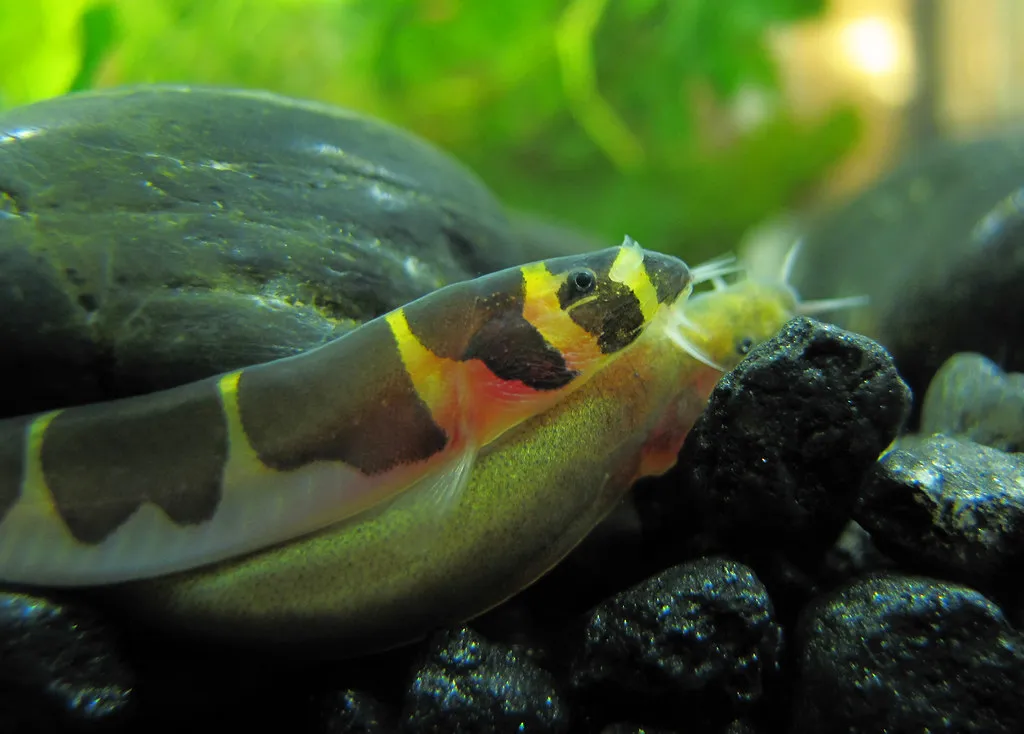
| Category | Details |
| Physical Characteristics | Kuhli Loaches are elongated and snake-like in appearance with a distinctive pattern of dark vertical bands on a light background. Their small size, reaching about 4 inches (10 cm), and sleek body make them agile and able to navigate through the aquarium easily. |
| Behavior and Temperament | These loaches are primarily nocturnal and tend to be shy, often hiding during the day. They are peaceful and enjoy burrowing in the substrate. When kept in groups, they become more active and visible, adding a delightful dynamic to the aquarium. |
| Water Parameter Compatibility | Kuhli Loaches prefer slightly acidic to neutral pH (6.0-7.0) and a temperature range of 75-86°F (24-30°C). They thrive in a well-established, densely planted tank with ample hiding spots, replicating their natural habitat in slow-moving, clear waters. |
| Dietary Needs | They are scavengers and eat a varied diet. Provide sinking pellets, bloodworms, brine shrimp, and other small, live or frozen foods. A well-rounded diet ensures their health and vitality, and feeding should ideally take place during the evening hours. |
| Tank Size and Grouping | A 20-gallon tank or larger is suitable for a group of Kuhli Loaches. They feel more secure and tend to be more active when kept in groups of at least six individuals. A well-furnished tank with hiding spots and soft substrate enhances their well-being. |
| Visual Appeal and Community Dynamics | Kuhli Loaches add an exotic element to the tank with their unique appearance and behavior. Their nocturnal activities and peaceful demeanor make them an interesting addition to a community aquarium. They coexist well with Glowlight Tetras and other peaceful fish. |
| Compatibility Considerations | Kuhli Loaches are peaceful and non-aggressive, making them excellent tank mates for Glowlight Tetras. Their compatible water parameters and feeding habits contribute to a harmonious community, enhancing the overall aesthetics and dynamics of the aquarium. |
Panda Loach
The Panda Loach (Yaoshania pachychilus) is a charming and peaceful freshwater fish known for its distinctive panda-like markings, making it a sought-after choice for aquarium enthusiasts. Its small size and unique appearance make it an attractive addition to a tank.
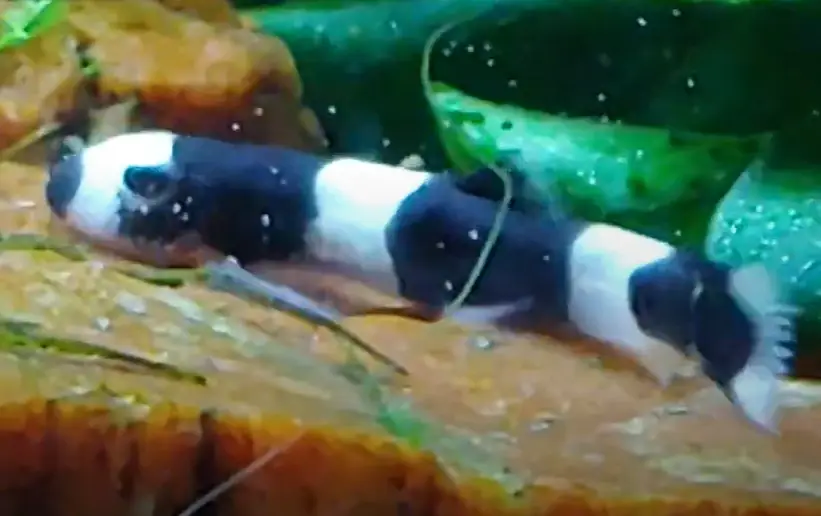
| Category | Details |
| Physical Characteristics | Panda Loaches have an elongated body with a cream or white coloration and distinctive black markings resembling a panda’s face. They grow to about 2.5 inches (6 cm) in length. Their vibrant contrast and intriguing pattern make them eye-catching inhabitants of any aquarium. |
| Behavior and Temperament | Panda Loaches are generally peaceful and sociable fish. They are active and enjoy exploring the aquarium, particularly during the night. They prefer the company of their own kind and thrive when kept in a group, displaying more natural and engaging behaviors. |
| Water Parameter Compatibility | Panda Loaches thrive in slightly acidic to neutral pH (6.0-7.5) and a temperature range of 73-79°F (23-26°C). Maintaining a well-filtered tank with good water quality and providing sufficient hiding spots and plant cover ensure their optimal health and happiness. |
| Dietary Needs | They are omnivores and accept a variety of foods, including sinking pellets, flakes, brine shrimp, bloodworms, and other small, live or frozen foods. Providing a diverse and well-rounded diet ensures their overall health and encourages natural foraging behaviors. |
| Tank Size and Grouping | A 15-gallon tank or larger is suitable for a small group of Panda Loaches. They prefer to be in groups, and a well-planted tank with soft substrate and hiding spots replicates their natural habitat, encouraging their playful and active behavior. |
| Visual Appeal and Community Dynamics | Panda Loaches enhance the visual appeal of the tank with their unique markings and vibrant contrast. They interact well with Glowlight Tetras and other peaceful community fish, adding a lively and charming dimension to the aquarium’s dynamics. |
| Compatibility Considerations | Panda Loaches’ peaceful temperament and compatible water parameters make them excellent tank mates for Glowlight Tetras. Their engaging behavior and eye-catching appearance contribute to an aesthetically pleasing and harmonious aquarium community. |
Weather Loach
The Weather Loach (Misgurnus anguillicaudatus), also known as Dojo Loach, is a fascinating freshwater fish with an elongated body and a playful personality. Its quirky behaviors, hardiness, and adaptability make it a popular choice among aquarists of all levels.
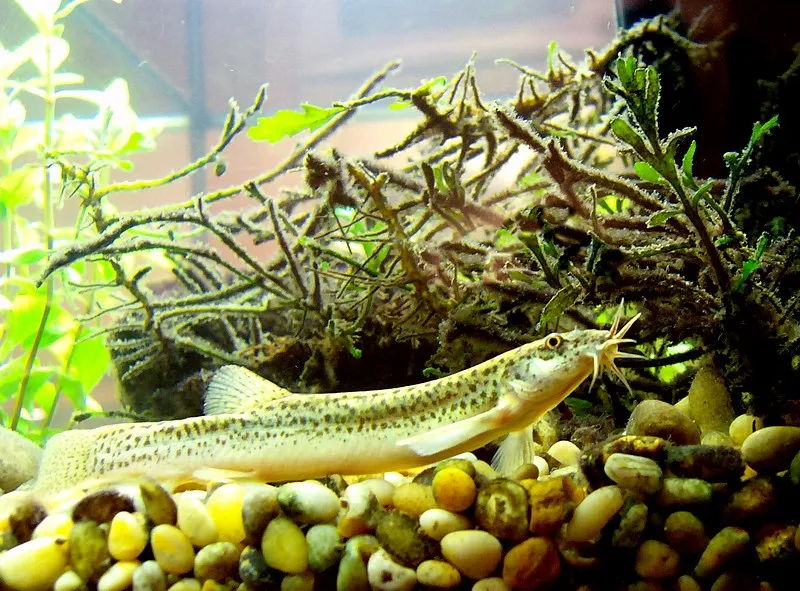
| Category | Details |
| Physical Characteristics | Weather Loaches have a slender, eel-like body with smooth skin and no scales. They can reach a length of about 6-12 inches (15-30 cm) in the aquarium. Their coloration is usually olive-green to yellow-brown, and they have a distinctive pair of whisker-like barbels near the mouth. |
| Behavior and Temperament | These loaches are known for their playful and entertaining behavior. They are active, social, and often seen exploring the tank, burrowing in the substrate, or even swimming upside down. They are peaceful and get along well with other non-aggressive tank mates. |
| Water Parameter Compatibility | Weather Loaches are hardy and adaptable to a wide range of water parameters. However, they prefer slightly acidic to neutral pH (6.0-7.5) and a temperature range of 50-77°F (10-25°C). Providing good filtration and regular water changes are crucial for their well-being. |
| Dietary Needs | They are omnivores and have a hearty appetite, accepting a varied diet. Offer a mix of sinking pellets, flakes, bloodworms, brine shrimp, and small pieces of vegetables. Feeding should be regular but in controlled portions to prevent overeating and maintain good health. |
| Tank Size and Grouping | Weather Loaches need a spacious tank due to their potential size. A tank of at least 30 gallons is suitable for a small group. They enjoy the company of their own kind, so it’s recommended to keep them in a group of at least three individuals for social interaction. |
| Visual Appeal and Community Dynamics | Weather Loaches add a delightful and quirky dimension to the aquarium with their playful antics. They coexist well with Glowlight Tetras and other peaceful community fish, creating an active and entertaining aquatic environment. Their unique behaviors captivate the observer. |
| Compatibility Considerations | Weather Loaches are peaceful and social, making them great companions for Glowlight Tetras. Their adaptable nature and playful behavior contribute to a lively and engaging community, enhancing the overall appeal of the aquarium. |
Zebra Loach
The Zebra Loach (Botia striata), also known as Striata Loach, is a charming and captivating freshwater fish admired for its striking zebra-like striped pattern. Its active nature, distinctive appearance, and compatibility with a variety of tank mates make it a sought-after choice.
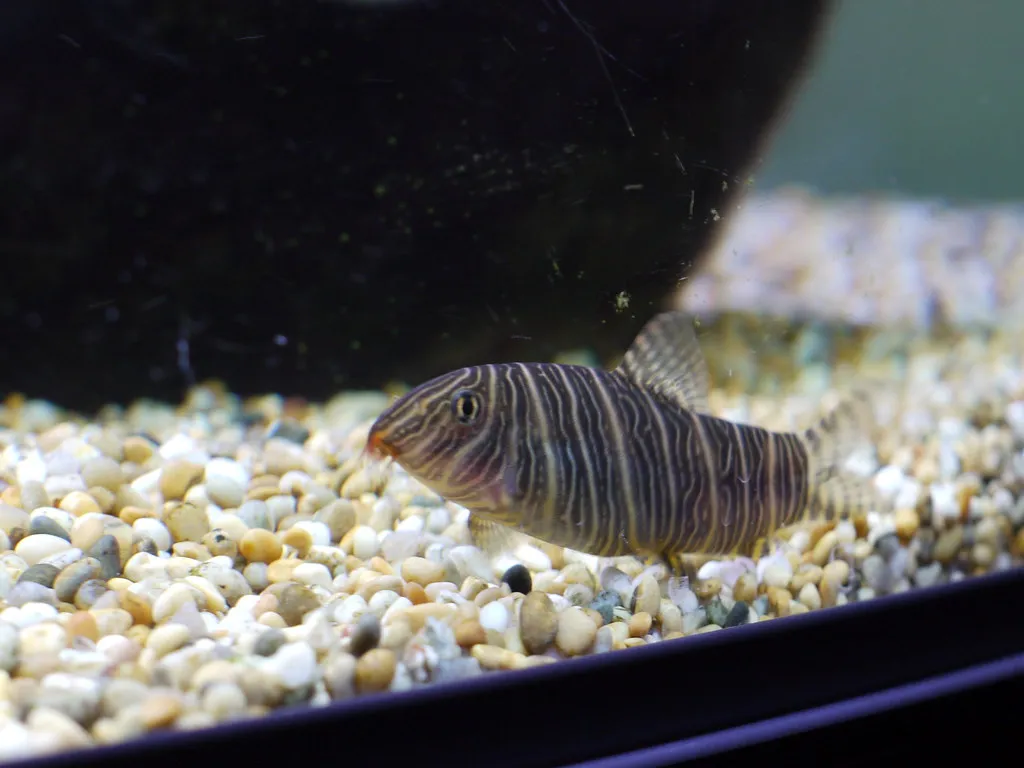
| Category | Details |
| Physical Characteristics | Zebra Loaches have a sleek, elongated body adorned with bold, horizontal black stripes resembling a zebra’s pattern. They can grow to about 4-5 inches (10-12 cm) in length. Their captivating appearance and active behavior make them a visually appealing addition to any tank. |
| Behavior and Temperament | These loaches are known for their playful and lively behavior. They are active swimmers and enjoy exploring the tank, particularly when provided with ample hiding spots and a well-structured aquarium. They are peaceful and can coexist with a variety of tank mates. |
| Water Parameter Compatibility | Zebra Loaches prefer slightly acidic to neutral pH (6.0-7.5) and a temperature range of 73-79°F (23-26°C). They appreciate good water movement and a well-filtered tank. Providing stable and suitable water conditions is essential for their health and overall well-being. |
| Dietary Needs | They are omnivores and accept a varied diet. Offer sinking pellets, flakes, bloodworms, brine shrimp, and small pieces of vegetables. Feeding them a well-rounded diet ensures their health and vitality, and they generally have a healthy appetite for a variety of foods. |
| Tank Size and Grouping | Zebra Loaches are social and thrive when kept in a group. A 30-gallon tank or larger is suitable for a small group of Zebra Loaches. They enjoy a well-structured tank with ample hiding places, rocks, and driftwood, providing a stimulating and secure environment for their activities. |
| Visual Appeal and Community Dynamics | Zebra Loaches add an intriguing and visually dynamic aspect to the tank with their distinctive striped pattern and lively movement. They coexist well with Glowlight Tetras and other peaceful community fish, contributing to an engaging and attractive aquatic environment. Their active behavior and charming appearance make them a delightful addition to any community tank. |
| Compatibility Considerations | Zebra Loaches are peaceful and social fish, often found in groups. They interact well with other community fish, including Glowlight Tetras, especially in a group setup. Their active and playful behavior can add to the liveliness of the tank. However, ensure tank mates are not aggressive or overly territorial as Zebra Loaches are more on the gentle side. |
Rasbora
Rasboras, like the Galaxy Rasbora and Harlequin Rasbora, are small, peaceful, and visually appealing. They add a serene charm to the tank alongside your glowlight tetras.
Chili Rasbora
Chili Rasbora (Boraras brigittae) is a captivating and tiny freshwater fish known for its vibrant coloration and peaceful nature. These miniature fish are a great addition to nano tanks and community setups, bringing color and energy to the lower levels of the aquarium.
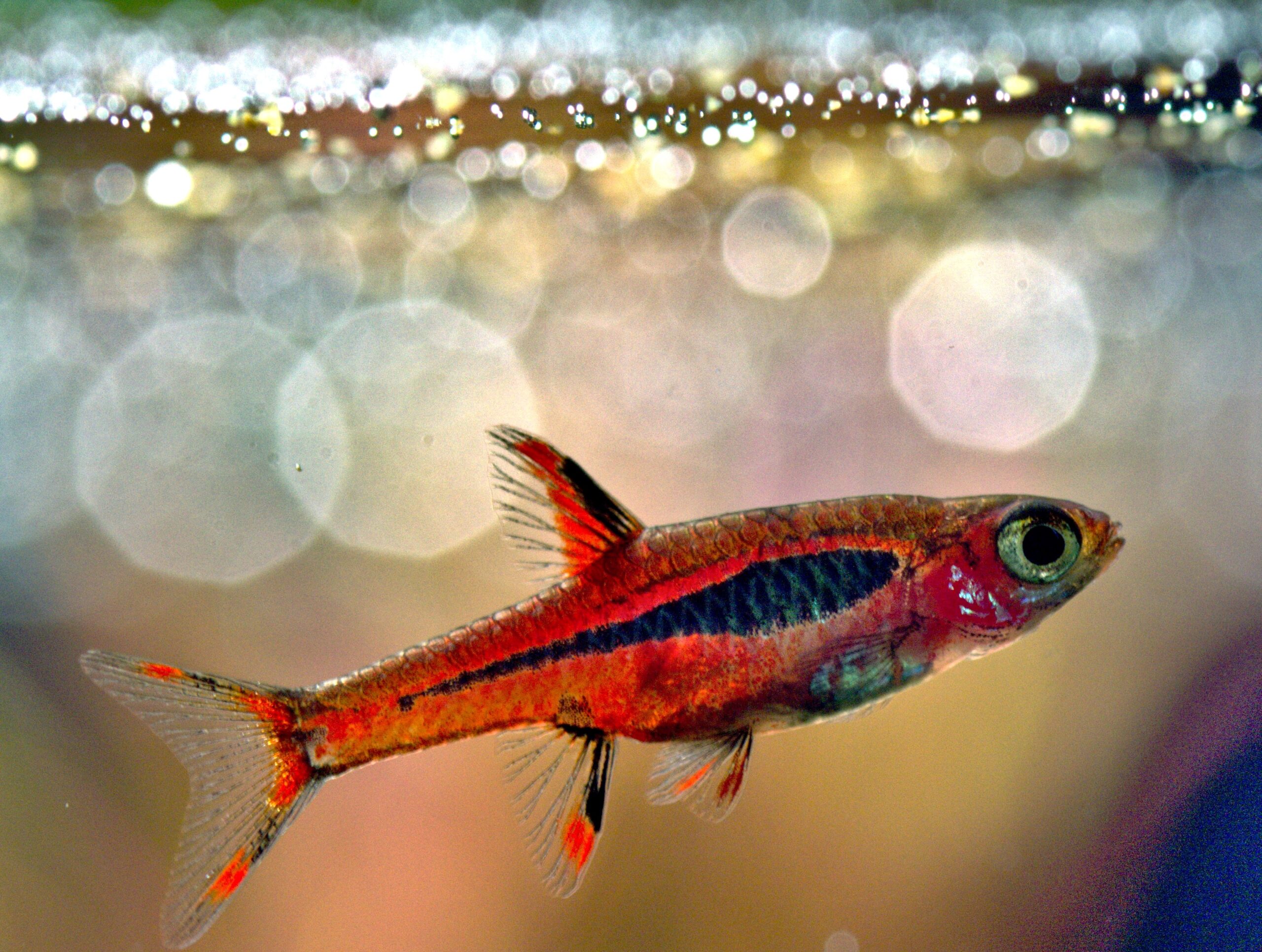
| Category | Details |
| Physical Characteristics | Chili Rasboras are incredibly small, usually reaching around 0.6-0.8 inches (1.5-2 cm) in length. They display striking red hues, resembling a chili pepper, hence the name. Their small size and eye-catching coloration make them a delightful and charming fish to have in an aquarium. |
| Behavior and Temperament | They are peaceful and timid fish, often found swimming in groups. Their shyness makes them appreciate well-planted tanks with plenty of hiding spots. Despite their small size, they are active swimmers and exhibit fascinating social behaviors, especially when kept in groups of their own kind. |
| Water Parameter Compatibility | Chili Rasboras prefer slightly acidic to neutral pH (6.0-7.0) and a temperature range of 75-82°F (24-28°C). They appreciate well-filtered and well-aerated water. Maintaining stable and suitable water conditions is crucial for their health, vitality, and vibrant coloration. |
| Dietary Needs | They are primarily micro predators, feeding on tiny invertebrates and zooplankton. In a home aquarium, they accept high-quality flakes, small pellets, and micro granules. Providing a varied diet ensures they receive the necessary nutrition for optimal health and coloration. |
| Tank Size and Grouping | Chili Rasboras are small and should be kept in groups of at least 8-10 individuals. A tank size of 10 gallons or more is suitable for a small school of Chili Rasboras. Planting the tank densely and providing hiding spots mimics their natural habitat, contributing to their comfort and well-being. |
| Visual Appeal and Community Dynamics | Chili Rasboras are captivating due to their vibrant red coloration, adding an eye-catching display to the lower levels of the tank. They coexist well with Glowlight Tetras and other small, peaceful fish, contributing to a visually appealing and harmonious community aquarium. Their striking appearance and schooling behavior make them a delightful addition to any setup. |
| Compatibility Considerations | Chili Rasboras are small and peaceful fish, making them ideal companions for Glowlight Tetras. They prefer being in a group and have a calm temperament. They interact well with other peaceful species, adding to the community dynamics. As long as tank mates are not aggressive, Chili Rasboras can thrive and contribute to a harmonious tank. |
Galaxy Rasbora
The Galaxy Rasbora (Celestichthys margaritatus), also known as Celestial Pearl Danio, is a tiny and dazzling freshwater fish celebrated for its captivating appearance and peaceful demeanor. Originating from Southeast Asia, these miniature fish add beauty and grace to planted aquariums and nano tanks.
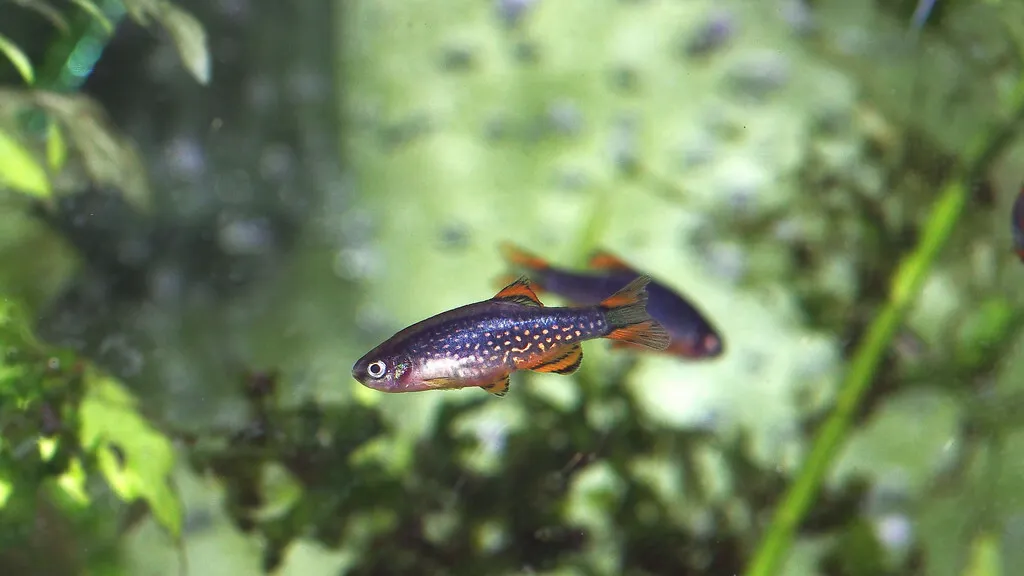
| Category | Details |
| Physical Characteristics | Galaxy Rasboras are small, typically growing to about 0.6-0.8 inches (1.5-2 cm) in length. They exhibit a captivating iridescent blue-green body adorned with bright red-orange markings resembling a galaxy, hence the name. Their stunning appearance makes them a popular choice for aquarists seeking visually appealing fish. |
| Behavior and Temperament | They are peaceful and sociable fish, often found in groups. Galaxy Rasboras are active swimmers and enjoy the middle and top levels of the tank. They prefer a well-planted tank with open swimming spaces, making them a great addition to community aquariums with other small, peaceful fish. |
| Water Parameter Compatibility | Galaxy Rasboras thrive in slightly acidic to neutral pH (6.5-7.5) and a temperature range of 73-79°F (23-26°C). Maintaining good water quality is vital for their well-being. Providing stable and suitable water conditions ensures they display their vibrant colors and remain healthy. |
| Dietary Needs | They are omnivores and accept a variety of foods, including high-quality flakes, pellets, small live or frozen foods, and micro granules. A well-rounded diet with regular feedings ensures they receive the essential nutrition for growth, color enhancement, and overall health. |
| Tank Size and Grouping | Galaxy Rasboras are schooling fish and should be kept in groups of at least 8-10 individuals. A tank size of 10 gallons or more is suitable for a school of Galaxy Rasboras. Providing ample swimming space and a planted environment mimicking their natural habitat contributes to their comfort and happiness. |
| Visual Appeal and Community Dynamics | Galaxy Rasboras are a stunning addition to the tank due to their mesmerizing coloration resembling a galaxy. They coexist well with Glowlight Tetras and other small, peaceful fish, adding visual appeal and a lively dynamic to the aquarium. Their captivating appearance and schooling behavior make them a delightful choice for any community setup. |
| Compatibility Considerations | Galaxy Rasboras, also known as Celestial Pearl Danios, are peaceful and small in size. They are compatible with Glowlight Tetras and other community fish that share a peaceful temperament. Due to their calm nature and small size, they usually do well in community tanks, provided the tank mates are not aggressive or significantly larger. |
Harlequin Rasbora
The Harlequin Rasbora (Trigonostigma heteromorpha), with its striking colors and playful behavior, is a favored choice among aquarists. Originating from Southeast Asia, this species is cherished for its beautiful appearance and peaceful temperament, making it an excellent companion for Glowlight Tetras and various community tanks.
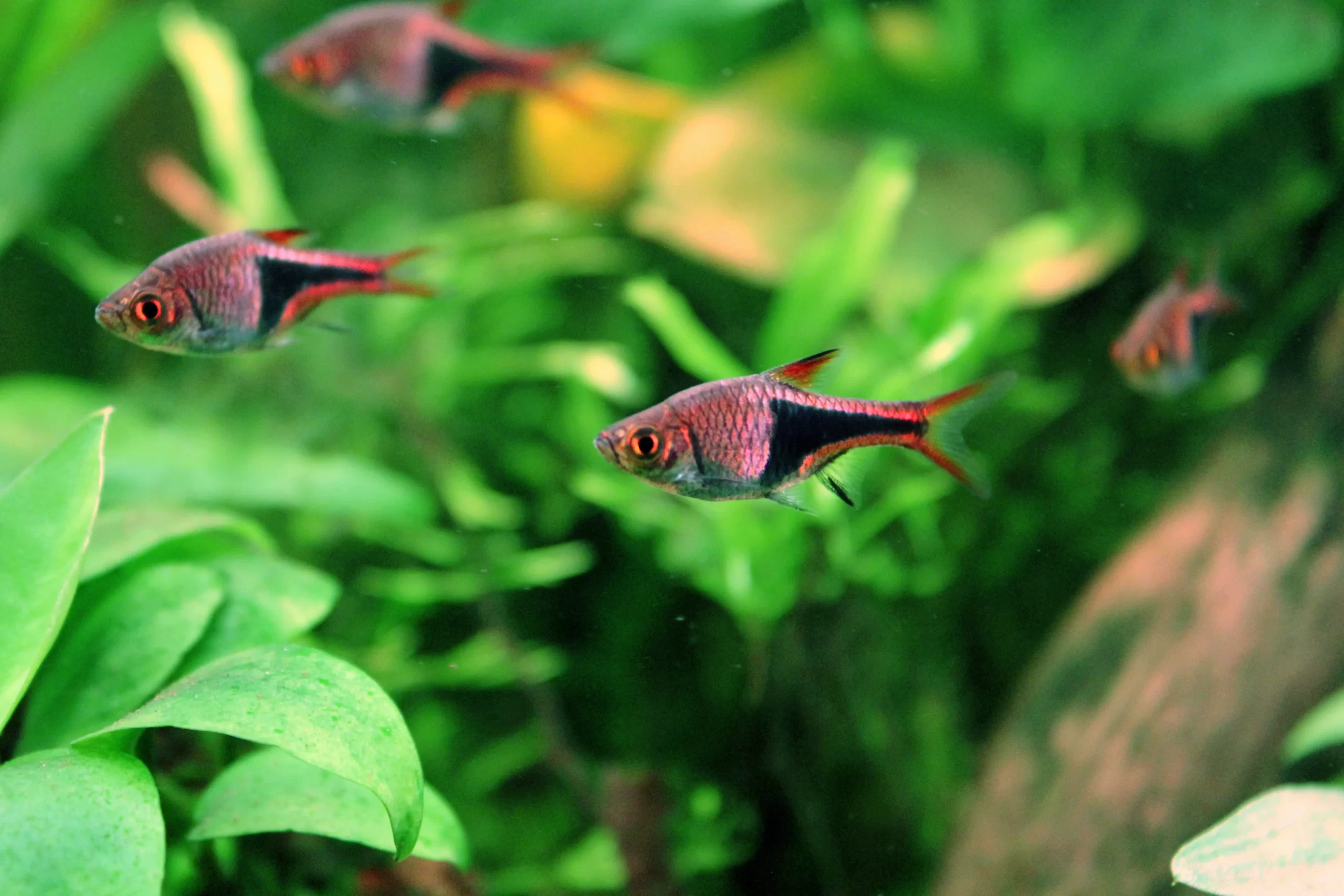
| Category | Details |
| Physical Characteristics | Harlequin Rasboras boast a slender, torpedo-like body and reach a size of around 1.5-2 inches (3.8-5 cm). Their defining features include a distinctive triangular patch of iridescent orange-red coloration, resembling a harlequin mask, against a silver-blue backdrop. Their vibrant and contrasting colors make them a stunning addition to any aquarium. |
| Behavior and Temperament | They are known for their active yet peaceful behavior. Harlequin Rasboras are sociable and often form shoals, making them a great choice for community setups. They enjoy the mid and top levels of the tank, making use of plants and decorations for hiding and exploring. Their playful interactions and peaceful nature enhance the aquarium’s liveliness. |
| Water Parameter Compatibility | Harlequin Rasboras prefer slightly acidic to neutral pH (6.0-7.8) and a temperature range of 72-78°F (22-26°C). They adapt well to a variety of water conditions, making them suitable for various tank setups. Providing stable water parameters contributes to their overall health and enhances their vibrant colors. |
| Dietary Needs | They are omnivores, accepting a wide range of foods, including high-quality flakes, pellets, small live or frozen foods, and micro granules. A well-balanced diet ensures they receive essential nutrients for growth, color enhancement, and overall well-being. Regular feeding routines help maintain their health and vitality. |
| Tank Size and Grouping | Harlequin Rasboras are social and prefer being in groups of at least 6-8 individuals. A tank size of 15 gallons or more is suitable for a community of Harlequin Rasboras. Providing adequate swimming space and a well-planted environment mimicking their natural habitat enhances their comfort and allows them to showcase their vibrant colors. |
| Visual Appeal and Community Dynamics | Harlequin Rasboras are prized for their eye-catching colors and fascinating patterns. They coexist harmoniously with Glowlight Tetras and other peaceful fish, creating an attractive and visually engaging community aquarium. Their vibrant appearance and playful interactions make them a popular and captivating choice for both beginner and experienced aquarists. |
| Compatibility Considerations | Harlequin Rasboras are peaceful, active, and known for their vibrant colors. They get along well with Glowlight Tetras and other community fish of similar temperament. Their schooling behavior adds an engaging element to the tank dynamics. It’s important to avoid pairing them with aggressive or fin-nipping species as they may stress the Harlequin Rasboras. |
Tetra
Tetras come in various colors and patterns. Choosing the right tetras, such as Neon Tetras or Rummy Nose Tetras, can complement and enhance your glowlight tetra setup.
Cardinal Tetra
Cardinal Tetras, scientifically known as Paracheirodon axelrodi, are vibrant and visually striking freshwater fish often admired for their bright red and blue hues. They are highly popular in the aquarium hobby.
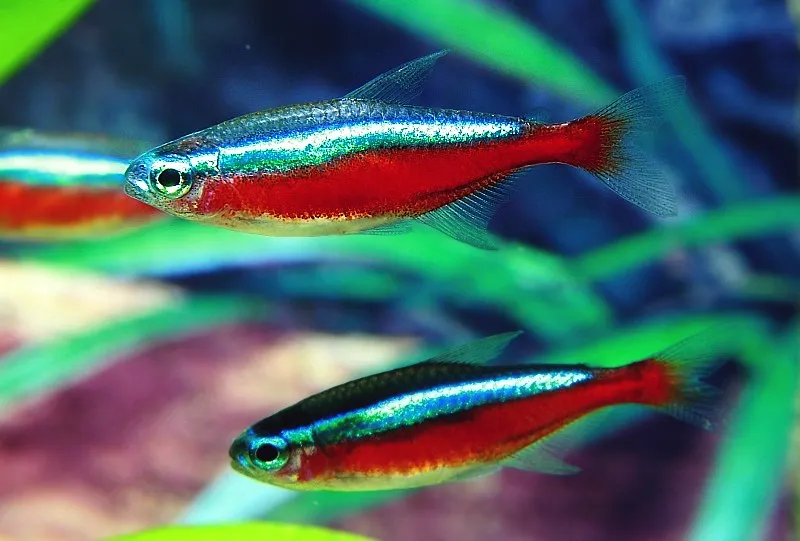
| Category | Details |
| Physical Characteristics | They showcase a distinctive red stripe running the length of their body, paralleled by a brilliant iridescent blue stripe. Cardinals are typically small, reaching about 1.5 inches in size. |
| Behavior and Temperament | Cardinal Tetras are known for their peaceful and schooling nature. They prefer to swim in schools, making them a perfect match for the schooling behavior of Glowlight Tetras. They add activity and beauty to the middle section of the tank. |
| Water Parameter Compatibility | They thrive in slightly acidic to neutral pH (around 6.0 – 7.0) and prefer a temperature range of 73-81°F (23-27°C), similar to the requirements of Glowlight Tetras. |
| Dietary Needs | Their diet mainly comprises small-sized foods like flakes, pellets, and small frozen or live foods. They are not demanding eaters and readily accept a variety of fish foods. |
| Tank Size and Grouping | A tank of 15 gallons or more is ideal for a small group of Cardinal Tetras. They are most content and display their natural schooling behavior when in a group of at least six individuals. |
| Visual Appeal and Community Dynamics | The vivid red and blue colors of Cardinal Tetras create a visually captivating contrast in an aquarium. Their schooling behavior and lively movement enhance the overall aesthetic of the tank. |
| Compatibility Considerations | Cardinal Tetras are peaceful and get along well with other fish. They share a similar peaceful temperament with Glowlight Tetras, making them great companions. |
Ember Tetra
Ember Tetras, scientifically known as Hyphessobrycon amandae, are charming, fiery-colored freshwater fish that add vibrancy and liveliness to any aquarium. They are relatively small in size but big in color and character.
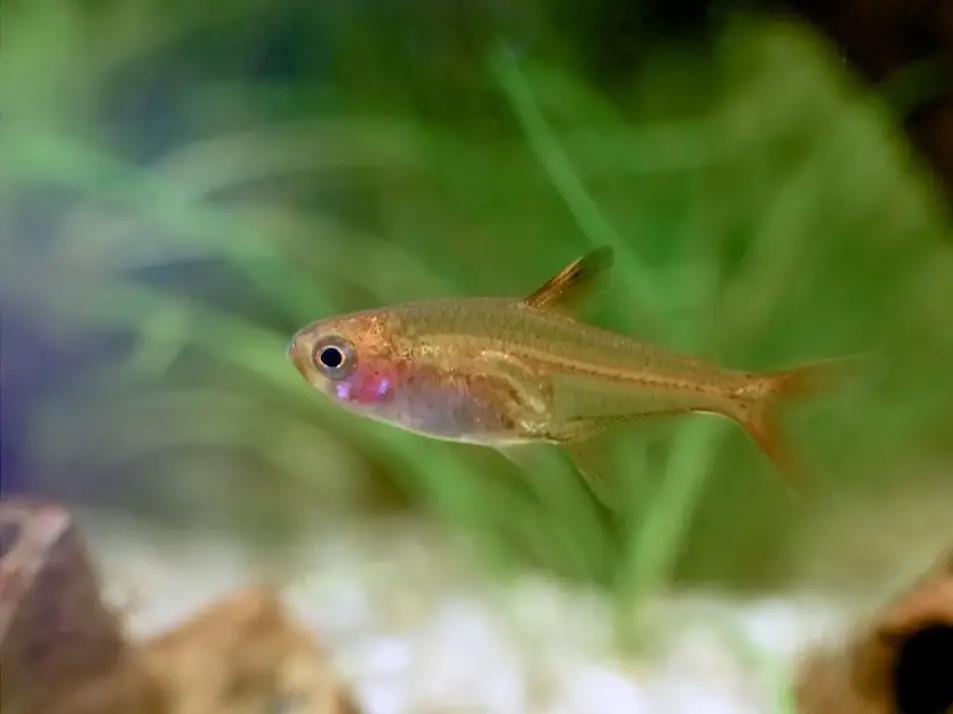
| Category | Details |
| Physical Characteristics | Ember Tetras are named for their striking ember-like reddish-orange hue that blankets their bodies. They are a compact fish, usually growing to about 1 inch. |
| Behavior and Temperament | Ember Tetras are peaceful and display active and playful behavior. They enjoy shoaling, making them a good match for Glowlight Tetras. Their vibrant colors and lively movements add a delightful spectacle to the tank. |
| Water Parameter Compatibility | They prefer slightly acidic to neutral pH (around 6.0 – 7.0) and a temperature range of 73-80°F (23-27°C), aligning well with the preferences of Glowlight Tetras. |
| Dietary Needs | These tetras are not picky eaters and readily consume most flake and pellet foods. A varied diet that includes small live or frozen foods further enhances their color and overall health. |
| Tank Size and Grouping | A tank of 10 gallons or more is suitable for a small group of Ember Tetras. They thrive in groups of six or more, providing comfort and enhancing their natural behaviors. |
| Visual Appeal and Community Dynamics | The fiery red-orange coloration of Ember Tetras offers a vibrant visual contrast in an aquarium. Their playful behavior and energetic swimming contribute to an active and engaging aquatic community. |
| Compatibility Considerations | Ember Tetras are peaceful and compatible with various community fish. They coexist harmoniously with Glowlight Tetras, amplifying the beauty and liveliness of the tank. |
Neon Tetra
Neon Tetras, scientifically known as Paracheirodon innesi, are one of the most iconic and popular freshwater fish in the aquarium hobby. Their striking and iridescent blue and red colors make them a standout choice for community aquariums.
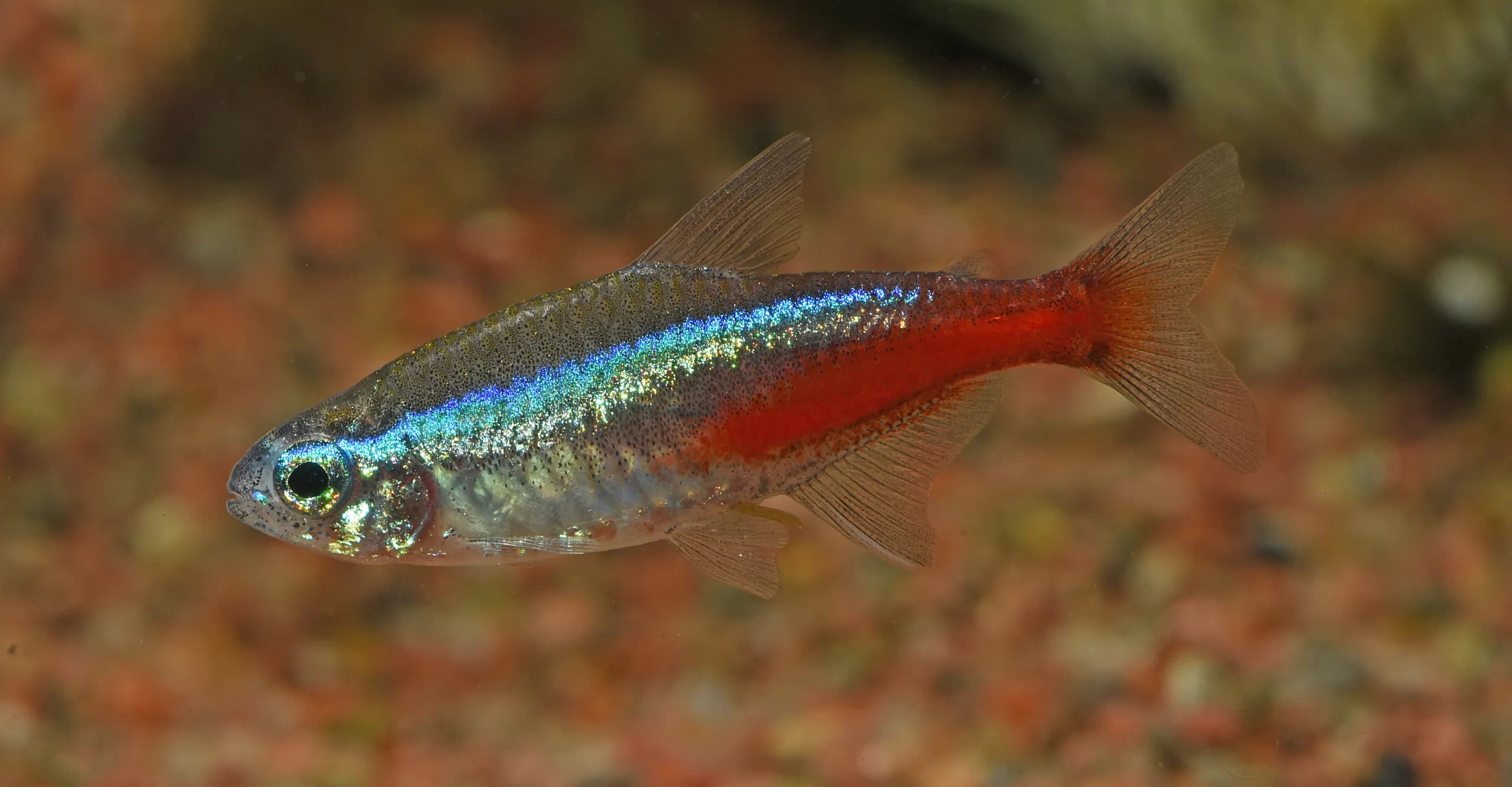
| Category | Details |
| Physical Characteristics | Neon Tetras are characterized by a vibrant blue horizontal line running along the length of their body, complemented by a bright red stripe just below it. They typically grow to about 1.5 inches in size. |
| Behavior and Temperament | Neon Tetras are peaceful and known for their active schooling behavior. They prefer swimming in groups, enhancing the beauty and activity in the middle and upper parts of the aquarium. They get along well with other community fish, including Glowlight Tetras. |
| Water Parameter Compatibility | They thrive in slightly acidic to neutral pH (around 6.0 – 7.5) and a temperature range of 70-81°F (21-27°C), aligning well with the preferences of Glowlight Tetras. |
| Dietary Needs | Neon Tetras have a varied diet, including flakes, micro pellets, and small-sized frozen or live foods. They readily accept a wide range of fish foods, ensuring ease of feeding in a community tank. |
| Tank Size and Grouping | A tank of 10 gallons or more is suitable for a small group of Neon Tetras. They are most content and visually appealing when kept in a group of at least six individuals. |
| Visual Appeal and Community Dynamics | The vibrant blue and red stripes of Neon Tetras add a mesmerizing and dynamic visual element to the tank. Their schooling behavior enhances the overall liveliness and aesthetic of the aquarium. |
| Compatibility Considerations | Neon Tetras are peaceful and sociable, making them excellent companions for Glowlight Tetras and other community fish. Their compatible temperament and stunning colors create a harmonious aquatic community. |
Rummy Nose Tetra
Rummy Nose Tetras, scientifically known as Hemigrammus rhodostomus, are highly recognized for their distinct red-nose feature and captivating silver-colored bodies. They bring a unique and appealing look to community aquariums.

| Category | Details |
| Physical Characteristics | The distinguishing feature of Rummy Nose Tetras is their bright red head and nose, contrasting against their silver-colored body. They typically grow to around 2 inches in size. |
| Behavior and Temperament | Rummy Nose Tetras are peaceful and active fish, frequently swimming in the middle and lower levels of the aquarium. They exhibit shoaling behavior and enjoy the company of their own kind as well as other peaceful community fish. |
| Water Parameter Compatibility | They prefer slightly acidic to neutral pH (around 6.0 – 7.0) and a temperature range of 75-82°F (24-28°C), aligning well with the preferences of Glowlight Tetras. |
| Dietary Needs | Rummy Nose Tetras are not picky eaters and accept various fish foods, including flakes, pellets, and small-sized live or frozen foods. Offering a diverse diet ensures their health and vitality. |
| Tank Size and Grouping | A tank of 15 gallons or more is appropriate for a small group of Rummy Nose Tetras. They are most visually appealing and exhibit their natural behaviors when kept in a group of at least six individuals. |
| Visual Appeal and Community Dynamics | The vibrant red nose of Rummy Nose Tetras adds a pop of color and visual interest to the tank. Their schooling behavior enhances the liveliness and harmony of the aquarium community. |
| Compatibility Considerations | Rummy Nose Tetras are peaceful and sociable, making them great companions for Glowlight Tetras and other peaceful community fish. Their unique appearance and compatible temperament contribute to a pleasing aquarium environment. |
White Skirt Tetra
Credit: https://www.youtube.com/watch?v=3hPTO6KFIxI
White Skirt Tetras, scientifically known as Gymnocorymbus ternetzi, are captivating and distinct due to their clear, skirt-like anal and pelvic fins. This characteristic sets them apart and makes them an attractive addition to community tanks.
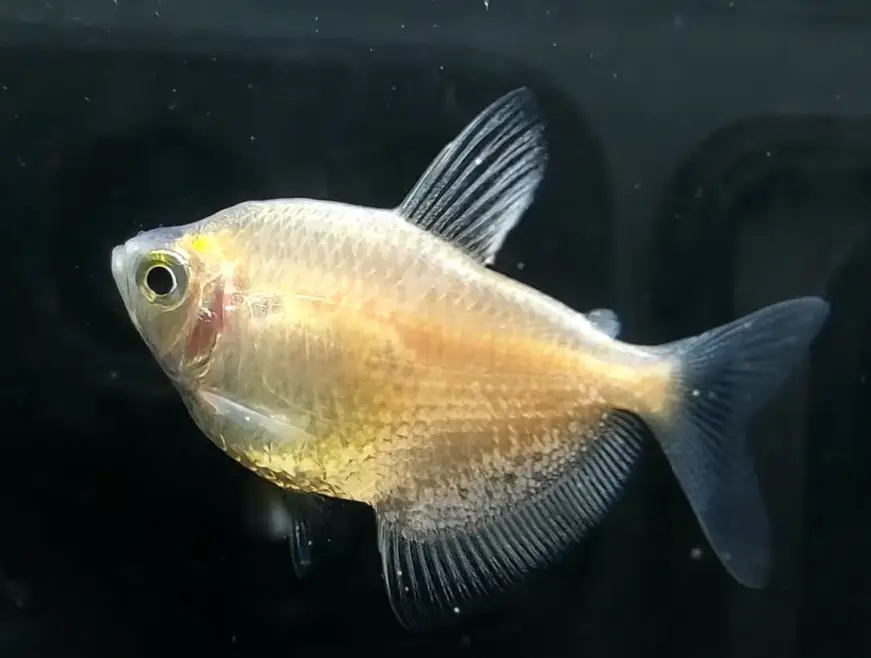
| Category | Details |
| Physical Characteristics | White Skirt Tetras have a transparent body with an elegant, flowing, skirt-like fin, giving them a delicate and graceful appearance. They typically grow to about 2.5 inches in size. |
| Behavior and Temperament | White Skirt Tetras are peaceful and sociable fish, generally staying in the middle and top levels of the aquarium. They are schooling fish and thrive in the company of their own kind and other community fish. |
| Water Parameter Compatibility | They prefer slightly acidic to neutral pH (around 6.0 – 7.5) and a temperature range of 70-79°F (21-26°C), which aligns well with the preferences of Glowlight Tetras. |
| Dietary Needs | White Skirt Tetras are omnivores and accept a variety of foods, including flakes, pellets, and live or frozen foods. Providing a balanced diet ensures their overall health and vitality. |
| Tank Size and Grouping | A tank of 20 gallons or more is suitable for a group of White Skirt Tetras. They thrive and display their natural behavior when kept in a group of at least six individuals. |
| Visual Appeal and Community Dynamics | The distinct skirt-like fins of White Skirt Tetras add elegance and grace to the tank. Their social and schooling behavior enhances the liveliness of the aquarium community. |
| Compatibility Considerations | White Skirt Tetras are peaceful and sociable, making them great companions for Glowlight Tetras and other community fish. Their unique appearance and compatible temperament contribute to a visually pleasing and harmonious aquarium. |
Black Neon Tetra
Black Neon Tetras, scientifically known as Hyphessobrycon herbertaxelrodi, are a variant of the popular Neon Tetras. They are cherished for their jet-black body and vivid neon stripe, creating a visually striking contrast.

| Category | Details |
| Physical Characteristics | Black Neon Tetras have a sleek, black body with a vibrant neon stripe that runs horizontally. This stripe adds a captivating contrast to their appearance. They typically grow to about 1.5-2 inches in size. |
| Behavior and Temperament | Black Neon Tetras are peaceful and active fish, often swimming in the middle and upper levels of the aquarium. They exhibit schooling behavior and enjoy being in the company of their own kind as well as other community fish. |
| Water Parameter Compatibility | They prefer slightly acidic to neutral pH (around 6.0 – 7.0) and a temperature range of 72-79°F (22-26°C), aligning well with the preferences of Glowlight Tetras. |
| Dietary Needs | Black Neon Tetras are not picky eaters and accept a variety of foods, including flakes, pellets, and small-sized live or frozen foods. A diverse diet ensures their health and vitality. |
| Tank Size and Grouping | A tank of 15 gallons or more is suitable for a small group of Black Neon Tetras. They display their natural behavior and are visually appealing when kept in a group of at least six individuals. |
| Visual Appeal and Community Dynamics | The sleek black body and striking neon stripe of Black Neon Tetras add a captivating contrast to the tank. Their schooling behavior enhances the liveliness and aesthetic of the aquarium. |
| Compatibility Considerations | Black Neon Tetras are peaceful and sociable, making them great companions for Glowlight Tetras and other community fish. Their unique appearance and compatible temperament create a visually pleasing and harmonious aquatic community. |
Black Skirt Tetra
Black Skirt Tetras, scientifically known as Gymnocorymbus ternetzi, are a popular and visually striking fish in the aquarium hobby. Their deep black or dark gray coloration and distinctive shape make them stand out in any community tank.
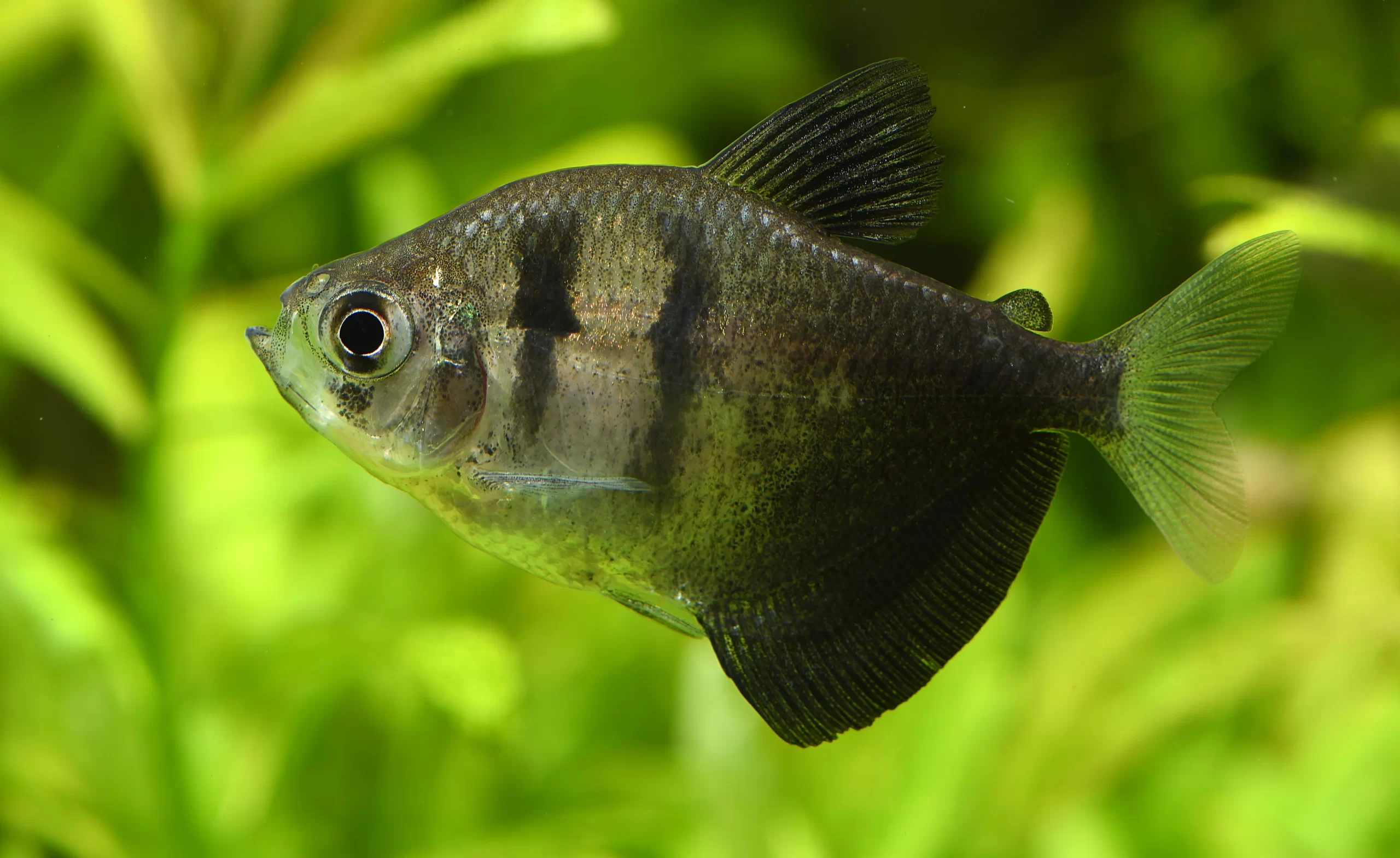
| Category | Details |
| Physical Characteristics | Black Skirt Tetras have a distinctive diamond-shaped body and a deep black or dark gray coloration, making them highly attractive. They typically grow to about 2.5-3 inches in size, showcasing their bold appearance. |
| Behavior and Temperament | These tetras are lively, peaceful, and active, often seen swimming in various levels of the aquarium. They can display shoaling behavior and are generally compatible with a variety of tank mates. |
| Water Parameter Compatibility | Black Skirt Tetras prefer slightly acidic to neutral pH (around 6.5 – 7.5) and a temperature range of 70-79°F (21-26°C), aligning well with the preferences of Glowlight Tetras. |
| Dietary Needs | They are omnivores and accept a range of foods including flakes, pellets, and live or frozen foods. Offering a varied diet ensures their overall health and vitality. |
| Tank Size and Grouping | A tank of 20 gallons or more is suitable for a group of Black Skirt Tetras. They enjoy being in groups and feel more secure, showcasing their natural behaviors. |
| Visual Appeal and Community Dynamics | The deep black or dark gray coloration of Black Skirt Tetras adds a contrasting and visually appealing element to the tank. Their lively behavior enhances the overall dynamics of the aquarium. |
| Compatibility Considerations | Black Skirt Tetras are generally peaceful and can coexist with Glowlight Tetras and various other community fish. Their bold appearance and compatible temperament contribute to an engaging and visually pleasing aquatic community. |
Barb
Barbs, including Cherry Barbs and Rosy Barbs, bring liveliness and vivid colors to the tank. Their active behavior makes them delightful companions for glowlight tetras.
Cherry barb
The Cherry Barb (Puntius titteya) is a popular choice among aquarists for its vibrant reddish-pink coloration. Originating from Sri Lanka, these fish are peaceful, active, and bring a burst of color to the tank, making them an attractive tank mate.
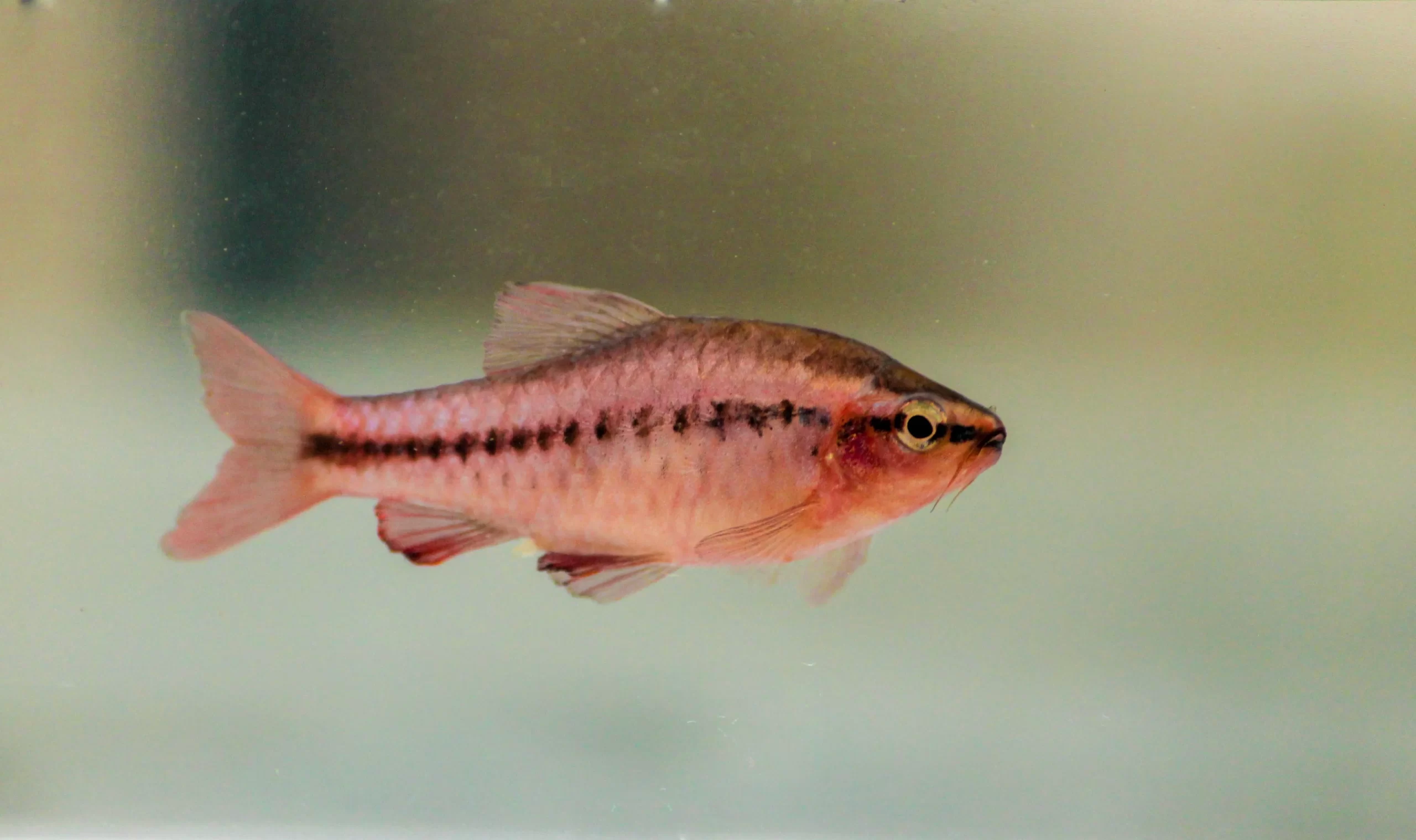
| Category | Details |
| Physical Characteristics | Cherry Barbs display a stunning reddish-pink hue, more pronounced in males. They have a streamlined body and can reach around 2 inches (5 cm) in size. This captivating coloration and modest size make them an appealing addition to community aquariums. |
| Behavior and Temperament | They are peaceful and active, often seen swimming in the middle and upper levels of the aquarium. They are schooling fish, and a group of Cherry Barbs creates a lively and dynamic environment, displaying intriguing social behaviors within their community. |
| Water Parameter Compatibility | Cherry Barbs prefer slightly acidic to neutral pH (6.0-7.0) and a temperature range of 73-81°F (23-27°C), aligning well with the conditions preferred by Glowlight Tetras. Maintaining appropriate water conditions is crucial for their health and vitality. |
| Dietary Needs | They are omnivores, with a diet primarily consisting of flake or pellet foods. They also enjoy occasional treats of live or frozen foods like bloodworms or brine shrimp. Providing a varied diet ensures their nutritional requirements are met and enhances their colors. |
| Tank Size and Grouping | A tank of 20 gallons or more is suitable for a group of Cherry Barbs. They thrive in schools of six or more, creating a visually stunning display. Providing ample swimming space and a well-planted tank replicates their natural habitat and ensures their well-being. |
| Visual Appeal and Community Dynamics | Cherry Barbs introduce vivid color and activity to the aquarium, making them a vibrant addition. They coexist well with Glowlight Tetras, enhancing the overall visual appeal and fostering a lively aquatic community. |
| Compatibility Considerations | Cherry Barbs’ peaceful temperament and compatibility with similar water parameters make them excellent tank mates for Glowlight Tetras. Their social nature and stunning colors contribute to a captivating and harmonious aquatic environment. |
Rosy Barb
The Rosy Barb (Puntius conchonius) is a lively and colorful freshwater fish known for its rosy or reddish hue. Originating from South Asia, they add vibrancy and activity to the aquarium. Rosy Barbs are a popular choice due to their appealing appearance.
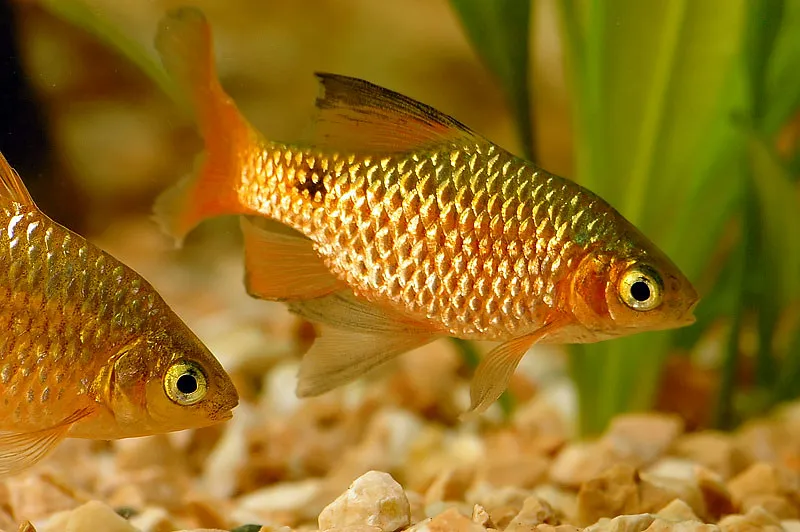
| Category | Details |
| Physical Characteristics | Rosy Barbs display a rosy to reddish-pink coloration, more vivid in males during breeding. They have an elongated body and can grow up to 6 inches (15 cm). Their stunning color and modest size make them an attractive and eye-catching addition to the tank. |
| Behavior and Temperament | They are active, social fish that enjoy swimming in the middle and upper levels of the tank. Rosy Barbs exhibit schooling behavior, and a group of them creates a lively and dynamic environment, showcasing fascinating interactions and group dynamics. |
| Water Parameter Compatibility | Rosy Barbs prefer slightly acidic to neutral pH (6.0-7.0) and a temperature range of 64-75°F (18-24°C), which is relatively cooler than the preferences of Glowlight Tetras. Adjusting the tank conditions to suit both species ensures a harmonious coexistence. |
| Dietary Needs | They are omnivores, with a diet consisting of flake or pellet foods. They also appreciate live or frozen foods like bloodworms and brine shrimp. Providing a varied diet meets their nutritional needs and supports their health and vibrancy in the aquarium. |
| Tank Size and Grouping | A tank of 30 gallons or more is suitable for a small group of Rosy Barbs. They are social and thrive in groups of six or more, contributing to a visually pleasing display. Ensuring adequate space and hiding spots enhances their overall well-being and behavior. |
| Visual Appeal and Community Dynamics | Rosy Barbs bring striking color and activity to the tank, making them an appealing choice. They coexist well with Glowlight Tetras, creating an engaging and visually appealing aquatic community. Their lively presence enhances the overall dynamics of the tank. |
| Compatibility Considerations | Rosy Barbs’ peaceful temperament and ability to adjust to similar water parameters make them suitable tank mates for Glowlight Tetras. Their vibrant coloration and social nature enrich the aquarium environment, promoting a harmonious and attractive aquatic community. |
Invertebrates
Invertebrates like Amano Shrimp or snails are excellent tank cleaners and can add an interesting dynamic to your tank’s ecosystem alongside glowlight tetras.
Snails
Snails are often considered beneficial tank mates in the aquarium. They help maintain the tank’s ecosystem by consuming algae and leftover food. Their gentle nature and unique appearance make them intriguing additions to the aquarium.
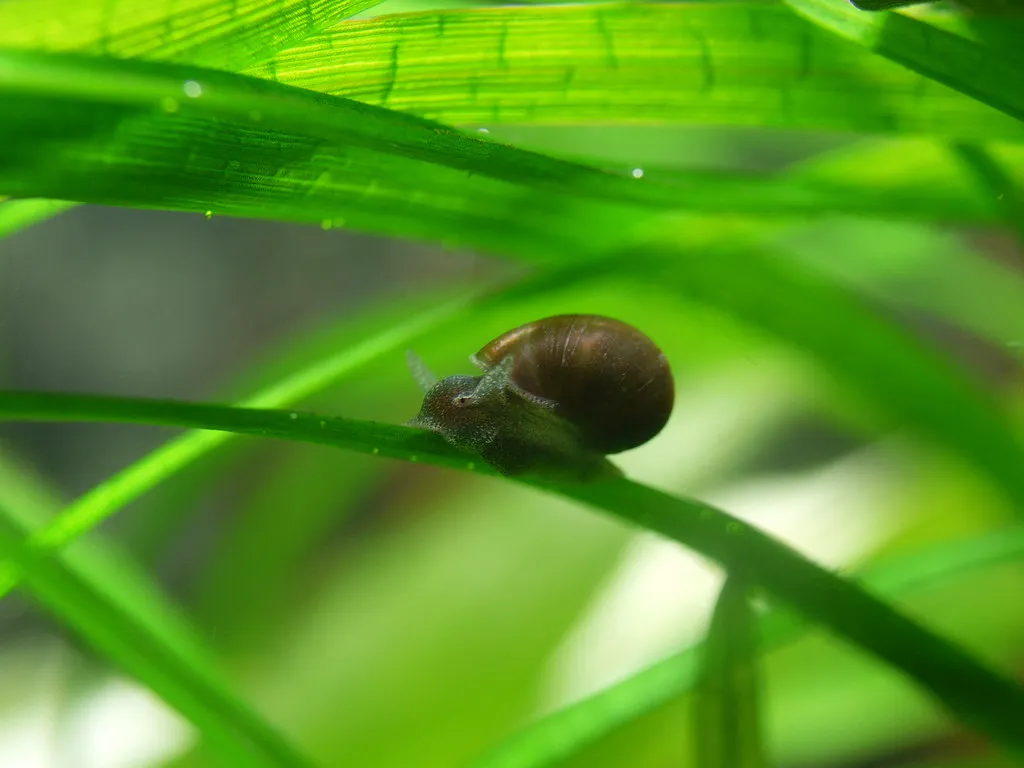
| Category | Details |
| Physical Characteristics | Snails come in various species, each with unique appearances. They typically have a spiral shell and a soft body. The shell’s color and pattern may vary, adding aesthetic interest to the tank. Their slow movement complements the active nature of fish. |
| Behavior and Temperament | Snails are generally peaceful and spend much of their time foraging for algae and scavenging for food. They don’t interfere with other tank mates and coexist peacefully. Their unhurried movements contribute to a calm and serene atmosphere in the aquarium. |
| Water Parameter Compatibility | Snails are highly adaptable to a range of water conditions. They can thrive in various pH levels and temperatures. This adaptability allows them to cohabit with Glowlight Tetras, as they can easily acclimate to the Tetras’ preferred water parameters. |
| Dietary Needs | Snails primarily feed on algae and leftover food. Their diet helps in keeping the tank clean and maintaining good water quality. Offering occasional supplemental food like blanched vegetables ensures they receive a balanced and nutritious diet. |
| Tank Size and Grouping | Snails do not require a lot of space and can thrive in tanks of various sizes. However, it’s essential not to overcrowd the tank to maintain a healthy balance. Having a moderate number of snails in the aquarium ensures they can contribute positively to the tank’s ecosystem. |
| Visual Appeal and Community Dynamics | Snails, with their distinctive appearance and movement, add visual interest to the tank. They contribute to a balanced and well-maintained aquatic environment. Their compatibility with Glowlight Tetras enhances the overall appeal and dynamics of the aquarium. |
| Compatibility Considerations | Snails are compatible tank mates for Glowlight Tetras due to their peaceful nature and beneficial contributions to the tank. They assist in algae control, promoting a cleaner environment. Their presence complements the lively and vibrant community created by Tetras. |
Amano Shrimp
Amano Shrimp (Caridina multidentata) are popular freshwater shrimp known for their algae-eating abilities and peaceful nature. They serve as excellent tank mates, contributing to a clean tank and adding a unique element to the aquarium.
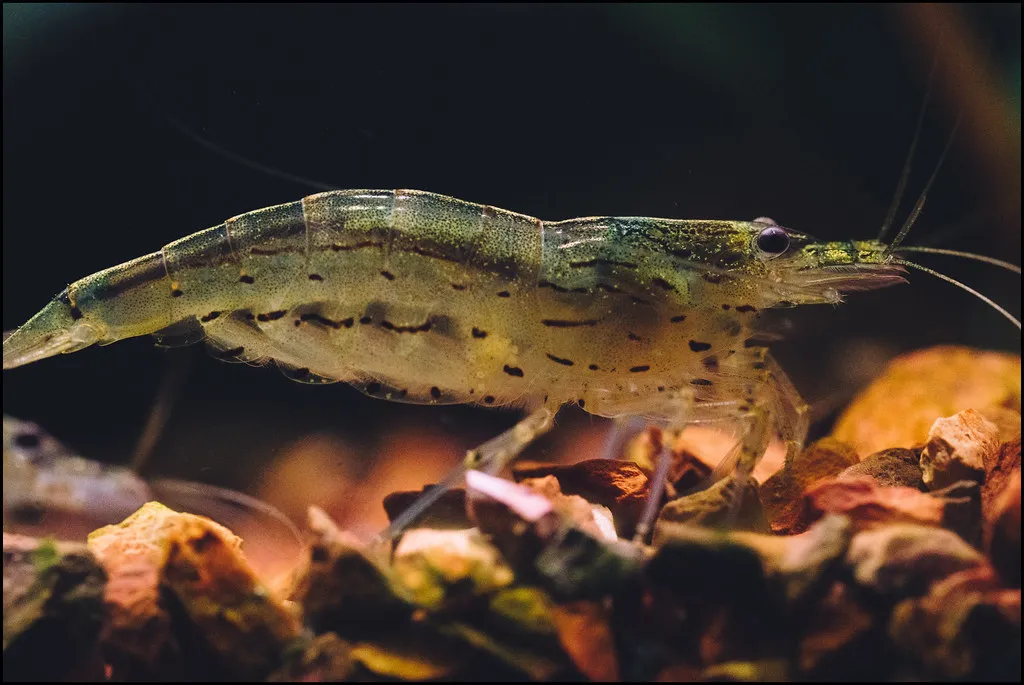
| Category | Details |
| Physical Characteristics | Amano Shrimp have a translucent or slightly greenish body, showcasing their internal organs. They possess a curved, almost hunched back, and their small size, usually around 2 inches (5 cm), makes them ideal inhabitants for community aquariums. |
| Behavior and Temperament | Amano Shrimp are peaceful and spend their time foraging for algae and scavenging for food. They are more active during the night and tend to hide during the day. Their scavenging behavior and calm temperament make them compatible with various fish species. |
| Water Parameter Compatibility | Amano Shrimp thrive in freshwater with a neutral pH (around 7.0) and a temperature range of 72-78°F (22-26°C). These parameters align well with the preferences of Glowlight Tetras, enabling them to coexist harmoniously and share the same aquatic environment. |
| Dietary Needs | Amano Shrimp are primarily algae eaters, consuming various types of algae in the aquarium. However, they also appreciate supplemental feeding with sinking pellets or algae wafers. A balanced diet ensures their health and vitality in the aquarium. |
| Tank Size and Grouping | Amano Shrimp can thrive in a 10-gallon tank or larger, and they prefer to live in groups. Keeping them in a group provides them with a sense of security and encourages their natural behaviors. However, it’s essential to ensure sufficient space and hiding spots for them. |
| Visual Appeal and Community Dynamics | Amano Shrimp, with their unique appearance and algae-clearing behavior, enhance the visual appeal of the tank. They contribute to a cleaner and well-maintained environment, complementing the vibrant and lively community created by Glowlight Tetras. |
| Compatibility Considerations | Amano Shrimp are compatible tank mates for Glowlight Tetras due to their peaceful nature and beneficial contributions. Their algae-eating behavior promotes a cleaner tank environment, enhancing the overall well-being of the aquarium. They coexist well with Glowlight Tetras and other peaceful fish, creating a harmonious and visually appealing aquatic community. |
Other Fish
Hatchetfish
Hatchetfish are small, peaceful fish known for their unique body shape, resembling a hatchet. They come in various species, each with vibrant colors, adding visual interest to the tank.
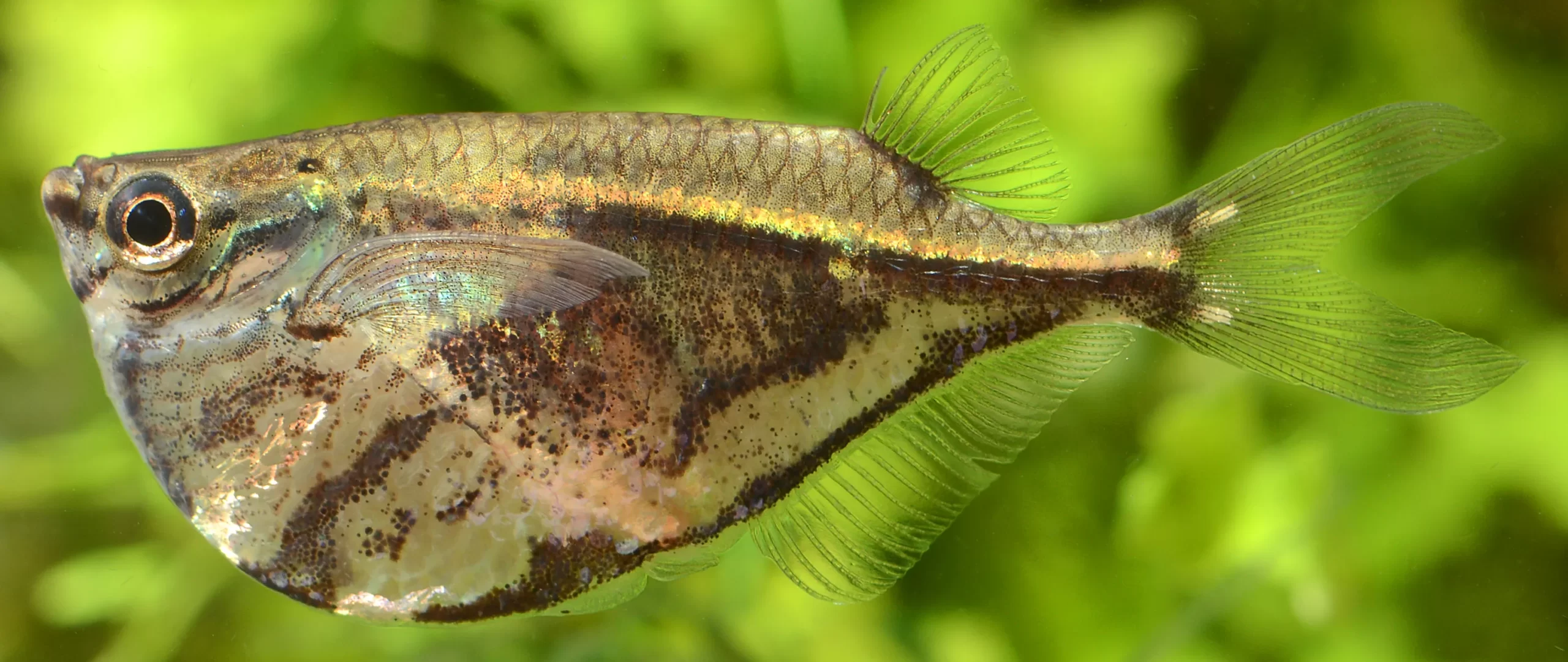
| Category | Details |
| Physical Characteristics | Hatchetfish have a distinctive flattened body shape, making them resemble a hatchet. They are generally small, measuring around 1.5 to 4 inches, with silver or iridescent coloration. |
| Behavior and Temperament | These fish are peaceful and prefer to stay near the water’s surface. They have a unique way of swimming, often resembling hovering or flying, making them an intriguing addition to the aquarium. |
| Water Parameter Compatibility | Hatchetfish prefer slightly acidic to neutral pH (6.0-7.0) and a temperature range of 73-82°F (23-28°C). They appreciate a well-planted tank with open spaces and dimmed lighting resembling their natural habitat. |
| Dietary Needs | Hatchetfish are carnivorous and thrive on a diet of flakes, freeze-dried bloodworms, brine shrimp, and insect larvae. Their feeding should include a mix of protein-rich foods to maintain optimal health. |
| Tank Size and Grouping | A tank of 20 gallons or more is suitable for a group of hatchetfish. They are shoaling fish, so keeping them in groups of six or more is ideal to ensure they feel secure and display their natural behaviors. |
| Visual Appeal and Community Dynamics | Hatchetfish add a unique visual appeal to the tank with their distinct body shape and iridescent colors. They are peaceful and coexist well with other peaceful community fish, enhancing the tank’s dynamics. |
| Compatibility Considerations | Hatchetfish are compatible with Glowlight Tetras due to their peaceful nature and preference for similar water conditions. Their surface-dwelling behavior complements the mid and lower-level activities of Glowlight Tetras. |
Siamese Algae Eater
Siamese Algae Eaters are popular in the aquarium hobby for their exceptional algae-eating abilities. They are a great choice to maintain a clean tank, making them ideal tank mates for various community fish.
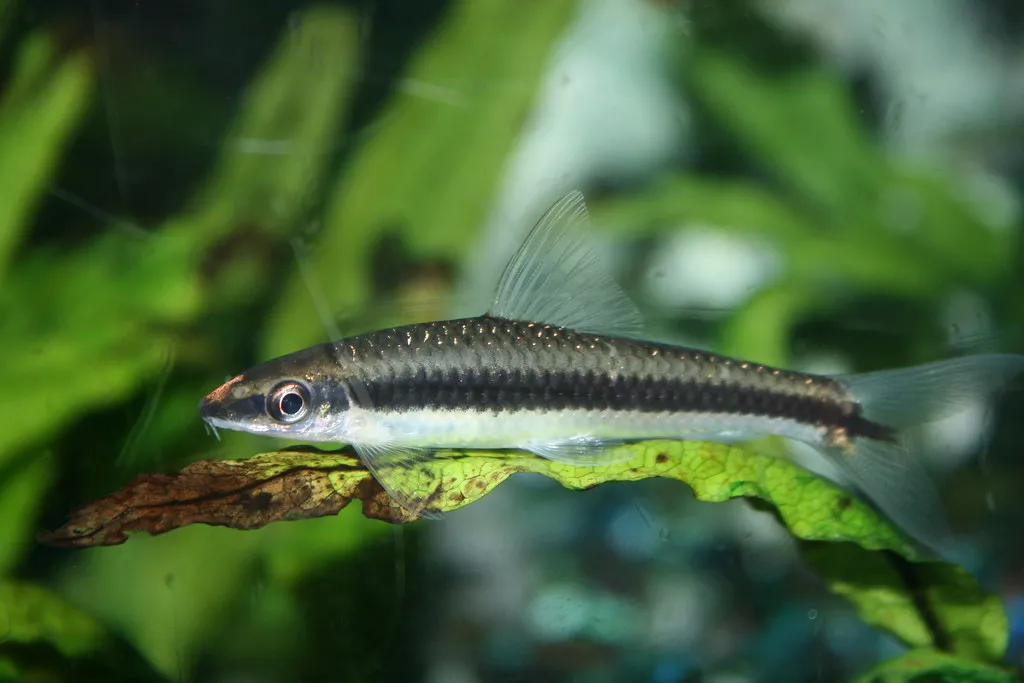
| Category | Details |
| Physical Characteristics | Siamese Algae Eaters have a slender body with a distinctive horizontal black stripe running from their head to tail. They typically grow up to 6 inches in length, showcasing a sleek, streamlined appearance. |
| Behavior and Temperament | These fish are peaceful and generally active. They spend a significant portion of their time scavenging for algae in the aquarium. They are compatible with a variety of community fish due to their peaceful nature. |
| Water Parameter Compatibility | Siamese Algae Eaters prefer slightly acidic to neutral pH (6.5-7.0) and a temperature range of 75-79°F (24-26°C). They adapt well to various water conditions, making them versatile additions to different tanks. |
| Dietary Needs | Siamese Algae Eaters primarily feed on algae but also accept commercial algae wafers and sinking pellets. Providing a balanced diet ensures their health and helps in controlling algae growth in the tank. |
| Tank Size and Grouping | A tank of at least 30 gallons is suitable for a group of Siamese Algae Eaters. They are social fish and thrive when kept in groups. Having companions helps reduce stress and encourages their natural behaviors. |
| Visual Appeal and Community Dynamics | Siamese Algae Eaters, while not the most vibrant in color, contribute to the tank’s cleanliness and overall aesthetics. They coexist well with other community fish and help maintain a well-balanced aquarium ecosystem. |
| Compatibility Considerations | Siamese Algae Eaters are compatible with Glowlight Tetras due to their peaceful temperament and algae-eating habits. They contribute to a cleaner tank, benefiting the overall health and appearance of the aquarium. |
White Cloud Mountain Minnow
The White Cloud Mountain Minnow (Tanichthys albonubes) is a small and vibrant freshwater fish native to China. With their striking coloration and peaceful nature, they make an excellent addition to a community tank, including alongside Glowlight Tetras.
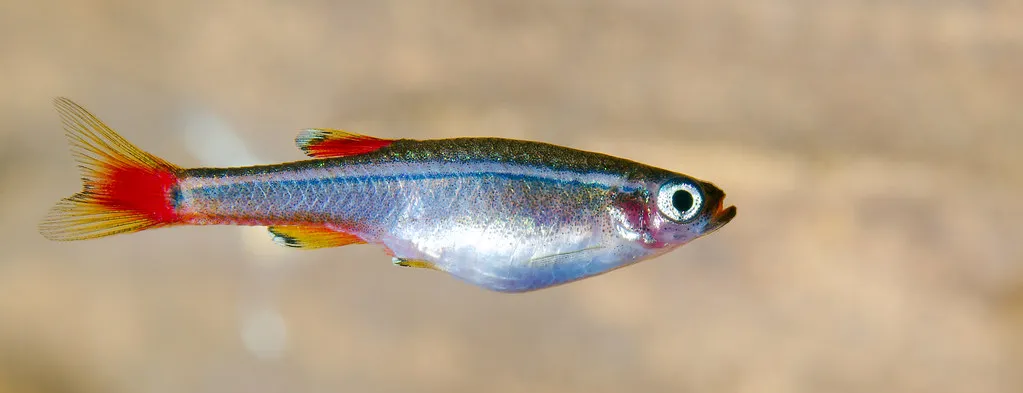
| Category | Details |
| Physical Characteristics | White Cloud Mountain Minnows are characterized by a slender body, typically displaying colors ranging from silver to golden. During breeding or when in good condition, their fins may display reddish or orange hues, adding to their visual appeal. |
| Behavior and Temperament | They are peaceful, active, and playful fish. They tend to occupy the upper and middle levels of the tank. White Clouds are schooling fish, and keeping them in a group of five or more enhances their well-being and displays their natural schooling behavior. |
| Water Parameter Compatibility | They prefer slightly acidic to slightly alkaline water (pH 6.0-7.5) and a temperature range of 64-72°F (18-22°C). These parameters align well with those preferred by Glowlight Tetras, promoting a compatible and comfortable environment for both species. |
| Dietary Needs | White Clouds are omnivores and enjoy a varied diet. They consume flake or pellet foods, as well as live or frozen foods like daphnia and brine shrimp. A well-balanced diet ensures their overall health, vitality, and coloration in the aquarium. |
| Tank Size and Grouping | They can thrive in a tank as small as 10 gallons, but a 20-gallon tank is preferable, especially when keeping them with other fish. They are social and thrive in groups of their own kind, adding to the visual appeal and dynamics of the aquarium. |
| Visual Appeal and Community Dynamics | White Cloud Mountain Minnows contribute to the overall aesthetics of the tank with their active swimming and vibrant coloration. They coexist well with Glowlight Tetras, creating an engaging and visually pleasing aquatic community. |
| Compatibility Considerations | Their peaceful nature and similar water parameter preferences make them compatible tank mates for Glowlight Tetras. White Cloud Mountain Minnows’ lively behavior and attractive appearance enhance the overall harmony and appeal of the aquarium. |
Fish to Avoid as Tank Mates for Glowlight Tetras
Aggressive Cichlids (e.g., Oscar, Jack Dempsey):
Aggressive cichlids can harass and even injure the peaceful and small glowlight tetras due to their aggressive territorial behavior. Cichlids require different water parameters and may outcompete the tetras for food.
Large Aggressive Barbs (e.g., Tiger Barb, Tinfoil Barb):
Large aggressive barbs can fin-nip and stress out the glowlight tetras, causing them significant harm. These barbs often need more space and have different water requirements, making them unsuitable tank mates.
Predatory Fish (e.g., Betta, Angelfish):
Predatory fish may view glowlight tetras as prey due to their small size. Betta fish, for example, are known to be aggressive and may attack the tetras. Additionally, these fish may have different water temperature preferences.
Large or Aggressive Catfish (e.g., Red-tailed Catfish, Tiger Shovelnose Catfish):
Large or aggressive catfish can potentially eat glowlight tetras or stress them out due to their size and aggression. They also have distinct dietary needs and often prefer different water conditions.
Excessive Bottom Feeders (e.g., Common Pleco, Carp):
Bottom feeders like common plecos or carp can outcompete glowlight tetras for food and create an unbalanced ecosystem. They can also grow large and require significant space and different water parameters.
Tropical Fish with Vastly Different Water Parameter Requirements (e.g., African Cichlids):
Fish from different regions may have significantly different pH, hardness, and temperature preferences. Keeping fish with vastly different water requirements can cause stress, health issues, and even fatalities among tank mates.
Fast and Active Fish (e.g., RainbowFish):
Extremely fast and active fish may outcompete glowlight tetras for food, especially during feeding times. This can lead to malnourishment and stress for the tetras.
Bigger or Aggressive Tetra Species (e.g., Serpae Tetra):
Larger and more aggressive tetra species may bully or nip at glowlight tetras due to their size and territorial behavior. Maintaining a harmonious tetra community requires careful consideration of each species’ temperament and size.
Tips for Caring for Glowlight Tetras and Their Tank Mates
Creating an Ideal Living Environment (Aquarium Maintenance)
As a responsible fish keeper, ensuring a well-maintained tank is your primary duty. When considering introducing different tank mates for your Glowlight Tetras, take note of whether they are schooling fish, as this is crucial.
Stability in tank temperature should be your top priority. Additionally, closely monitor the tank’s pH level, considering that various fish may require specific water conditions.
For schooling fish, it’s essential to allocate one gallon of water for each fish. Overstocking the tank should be avoided, as it can lead to suboptimal water conditions and potential harm to your fish.
Before adding new fish to your tank, ascertain if any adjustments need to be made. Consult with the seller or breeder regarding the specific water conditions required by the fish.
While many fish from the list above thrive in tanks with abundant live plants that mimic their natural habitats, it’s essential not to overcrowd the tank with vegetation. Schooling fish need ample space to swim freely in their groups.
Related Article: Step-By-Step Guide To Breed Glowlight Tetra Successfully
Feeding Routine
Maintaining an effective feeding schedule becomes challenging when you have various schools of fish coexisting in the same tank. To ensure each school receives sufficient and appropriate food for their health, you may need to divert the attention of one school to one end of the tank while feeding the other school separately.
Maintaining Social Groups
Lastly, it’s crucial to prioritize the social aspect, especially for the schooling fish mentioned in the list above. Keeping them in groups is essential to prevent high levels of stress, stunted growth, infertility, or susceptibility to diseases.
Learn more about Glowlight Tetra diseases, and how to treat them.
FAQs
Do Glowlight Tetras Get Along with Other Tetra Species?
Yes, glowlight tetras generally get along with other tetra species, creating a visually appealing and active community. Tetras like neon tetras, cardinal tetras, and ember tetras are often good choices.
Are There Any Fish to Avoid Keeping with Glowlight Tetras?
It’s advisable to avoid aggressive or fin-nipping fish like larger cichlids or aggressive barbs. Additionally, predatory fish that may see glowlight tetras as prey should be avoided.
Can I Keep Bottom-Dwelling Fish with Glowlight Tetras?
Yes, bottom-dwelling fish like corydoras catfish and loaches are excellent tank mates for glowlight tetras. They occupy different levels of the tank, promoting a balanced and engaging community.
What Tank Size is Ideal for a Community of Glowlight Tetras and Their Tank Mates?
A tank of at least 30 Gallons is suitable for a community of glowlight tetras and their tank mates. Sufficient space ensures they have room to swim and explore comfortably.
What Water Parameters Should I Maintain for Glowlight Tetra Tank Mates?
Maintain a pH range of 6.0-7.0 and a temperature between 72-78°F (22-26°C) to suit the preferences of most glowlight tetra tank mates. Water hardness and clarity are also important considerations.
Are Invertebrates Suitable Tank Mates for Glowlight Tetras?
Yes, peaceful invertebrates like amano shrimp or nerite snails can be compatible tank mates with glowlight tetras. They help maintain tank cleanliness and add visual interest.
Conclusion
In the world of aquariums, finding the ideal companions for your Glowlight Tetras can transform your aquatic habitat into a captivating spectacle. Each tank mate, from the graceful Rasboras to the energetic Tetras, brings its own distinct colors to this living gallery. By considering factors like size, behavior, and water preferences, you can curate an aquatic community that coexists harmoniously. Opt for companions that not only enhance the fascinating nature of Glowlight Tetras but also contribute to a visually stunning and well-balanced aquarium. With the right mix of tank mates, you’re not just creating an underwater habitat; you’re crafting an aquatic masterpiece.
